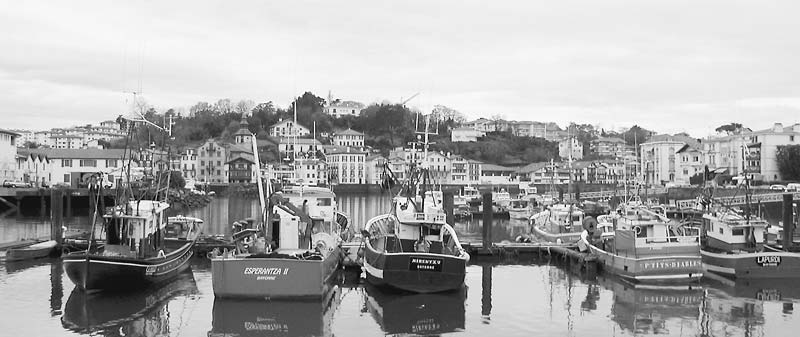
Euskal Herria
French Basque Country (Le Pays Basque)
St-Jean-de-Luz / Donibane Lohizune
Villages in the French Basque Country
Spanish Basque Country (El País Vasco)
Map: Hotels & Restaurants in Bilbao’s Old Town
Straddling two nations on the Atlantic Coast—stretching about 100 miles from Bayonne, France, south to Bilbao, Spain—lies the ancient, free-spirited land of the Basques. The Basque Country is famous for its sunny beaches and scintillating modern architecture... and for its feisty, industrious natives. It’s also simply beautiful: Bright white chalet-style homes with deep-red and green shutters scatter across lush, rolling hills; the Pyrenees Mountains soar high above the Atlantic; and surfers and sardines share the waves.
Insulated from mainstream Europe for much of their history, the plucky Basques have wanted to be left alone for more than 7,000 years. An easily crossed border separates the French Pays Basque from the Spanish País Vasco, allowing you to sample both sides from a single base (in France, I hang my beret in cozy St-Jean-de-Luz; in Spain, I prefer fun-loving San Sebastián).
Much unites the French and Spanish Basque regions: They share a cuisine, Union Jack–style flag (green, red, and white), and common language (Euskara), spoken by about a half-million people. (Virtually everyone also speaks French and/or Spanish.) And both have been integrated by their respective nations, sometimes forcibly. The French Revolution quelled French Basque ideas of independence; 130 years later, Spain’s fascist dictator, Generalísimo Francisco Franco, attempted to tame his own separatist-minded Basques.
But over the past few generations, things have started looking up. The long-suppressed Euskara language is enjoying a resurgence. And, as the European Union celebrates ethnic regions rather than nations, the French and Spanish Basques are feeling more united. This heavily industrialized region is enjoying a striking 21st-century renaissance. In France, long-ignored cities such as Bayonne and the surfing mecca of Biarritz are being revitalized. And in Spain, the dazzling architecture of the Guggenheim Bilbao modern-art museum and the glittering resort of San Sebastián are drawing enthusiastic crowds. At the same time, traditional small towns—like France’s St-Jean-de-Luz and nearby mountain villages, and Spain’s Lekeitio and Hondarribia—are also thriving, making the entire region colorful, fun, welcoming...and unmistakably Basque.
One day is enough for a quick sample of the Basque Country, but two or three days lets you breathe deep and hold it in. Where you go depends on your interests: France or Spain? Cities (such as Bayonne and Bilbao) or resorts (such as St-Jean-de-Luz and San Sebastián)?
If you want to slow down and focus on Spain, spend one day relaxing in San Sebastián and the second side-tripping to Bilbao (and Guernica, if you have a car).
Better yet, Basque on both sides of the border. Sleep in one country, then side-trip into the other, devoting one day to France (St-Jean-de-Luz and Bayonne), and a second day to Spain (San Sebastián and maybe Bilbao).
Wherever you go, your Basque sightseeing should be a fun blend of urban, rural, cultural, and culinary activities.
The tourist’s Basque Country—from Bayonne to Bilbao—stays close to the coastline. Fortunately, everything is connected by good roads and public transportation.
By Bus and Train: In France, the three main towns (St-Jean-de-Luz, Bayonne, and Biarritz) are connected by bus (trains also zip between St-Jean-de-Luz and Bayonne). Even if you rent a car, I’d do these three towns by public transit. To go between France and San Sebastián, a train—with a transfer in Hendaye—is your best bet. From San Sebastián, the bus is the best way to reach Bilbao (and from there, Guernica). Specific connections are explained in each section.
Note that a few out-of-the-way areas—France’s Basque villages of the interior and Spain’s Bay of Biscay—are impractical by public transportation...but worth the trouble by car.
By Car: Bayonne, St-Jean-de-Luz, San Sebastián, and Bilbao are connected by a convenient expressway, called A-63 in France and A-8 in Spain (rough timings: Bayonne to St-Jean-de-Luz, 30 minutes; St-Jean-de-Luz to San Sebastián, 45 minutes; San Sebastián to Bilbao, 1.25 hours).
Language Warning: For the headers throughout this chapter, I’ve listed place names using the French or Spanish spelling first and the Euskara spelling second. In the text, I use the spelling that prevails locally. While most people refer to towns by their French or Spanish names, many road signs list places in Euskara. (In less separatist-minded France, signs are often only in French. But in Spain, signs are usually posted in both Euskara and Spanish, either on the same sign or with dual signage on opposite sides of the street.) The French or Spanish version is sometimes scratched out by locals, so you might have to navigate by Euskara names.
Also note that in terms of linguistic priority (e.g., museum information), Euskara comes first, French and Spanish tie for second, and English is a distant fourth...and it often doesn’t make the cut.
Mixing influences from the mountains, sea, France, and Spain, Basque food is reason enough to visit the region. The local cuisine—dominated by seafood, tomatoes, and red peppers—offers some spicy dishes, unusual in most of Europe. And though you’ll find similar specialties throughout the Basque lands, France is still France and Spain is still Spain. Here are some dishes you’re most likely to find in each area.
French Basque Cuisine: The red peppers (called piments d’Espelette) hanging from homes in small villages give foods a distinctive flavor and often end up in piperade, a dish that combines peppers, tomatoes, garlic, ham, and eggs. Peppers are also dried and used as condiments. Look for them with the terrific Basque dish axoa (a veal or lamb stew on mashed potatoes). Look also for anything “Basque-style” (basquaise)—cooked with tomato, eggplant, red pepper, and garlic. Don’t leave without trying ttoro (tchoo-roh), a seafood stew that is the Basque Country’s answer to bouillabaisse and cioppino. Marmitako is a hearty tuna stew. Local cheeses come from Pyrenean sheep’s milk (pur brebis), and the local ham (jambon de Bayonne) is famous throughout France. After dinner try a shot of izarra (herbal-flavored brandy). To satisfy your sweet tooth, look for gâteau basque, a local tart filled with pastry cream or cherries from Bayonne. Hard apple cider is a tasty and local beverage. The regional wine Irouléguy comes in red, white, and rosé, and is the only wine produced in the French part of Basque Country (locals like to say that it’s made from the smallest vineyard in France but the biggest in the Northern Basque Country).
Spanish Basque Cuisine: Hopping from bar to bar sampling pintxos—the local term for tapas—is a highlight of any trip (for details, see the sidebar on here). Local brews include sidra (hard apple cider) and txakolí (cha-koh-LEE, a light, sparkling white wine—often theatrically poured from high above the glass for aeration). You’ll want to sample the famous pil-pil, made from emulsifying the skin of bacalao (dried, salted cod) into a mayonnaise-like substance with chili and garlic. Another tasty dish is kokotxas, usually made from hake (merluza) fish cheeks, prepared like pil-pil, and cooked slowly over a low heat so the natural gelatin is released, turning it into a wonderful sauce—¡qué bueno! Look also for white asparagus from Navarra. Wine-wise, I prefer the reds and rosés from Navarra. Finish your dinner with cuajada, a yogurt-like, creamy milk dessert that’s sometimes served with honey and nuts. Another specialty, found throughout Spain, is membrillo, a sweet and muy dense quince jelly. Try it with cheese for a light dessert, or look for it at breakfast.
Compared to their Spanish cousins across the border, the French Basques seem French first and Basque second. You’ll see less Euskara writing here than in Spain, but these destinations have their own special spice, mingling Basque and French influences with beautiful rolling countryside and gorgeous beaches.
Just 45 minutes apart by car, San Sebastián and St-Jean-de-Luz bridge the Spanish and French Basque regions. Between them you’ll find the functional towns of Irún (Spain) and Hendaye (France), and the delightful hill town of Hondarribia, which is worth a visit if you have time to spare (see here).
My favorite home base here is the central, comfy, and manageable resort village of St-Jean-de-Luz. It’s a stone’s throw to Bayonne (with its “big-city” bustle and good Basque museum) and the snazzy beach town of Biarritz. A drive inland rewards you with a panoply of adorable French Basque villages. And St-Jean-de-Luz is a relaxing place to “come home” to, with its mellow ambience, fine strolling atmosphere, and good restaurants.
St-Jean-de-Luz (san zhahn-duh-looz) sits cradled between its small port and gentle bay. The days when whaling, cod fishing, and pirating made it wealthy are long gone, but don’t expect a cute Basque backwater. Tourism has become the economic mainstay, and it shows. Pastry shops serve Basque specialties, and store windows proudly display berets (a Basque symbol). Ice-cream lickers stroll traffic-free streets, while soft, sandy beaches tempt travelers to toss their itineraries into the bay. The knobby little mountain La Rhune towers above the festive scene. Locals joke that if it’s clear enough to see La Rhune’s peak, it’s going to rain, but if you can’t see it, it’s raining already.
The town has little of sightseeing importance, but it’s a good base for exploring the Basque Country and a convenient beach and port town that provides the most enjoyable dose of Basque culture in France. The town fills with French tourists in July and August—especially the first two weeks of August, when it’s practically impossible to find a room without a reservation made long in advance...or even walk down the main street.
St-Jean-de-Luz’s old city lies between the train tracks, the Nivelle River, and the Atlantic. The main traffic-free street, Rue Gambetta, channels walkers through the center, halfway between the train tracks and the ocean. The small town of Ciboure, across the river, holds nothing of interest.
The only sight worth entering in St-Jean-de-Luz is the church where Louis XIV and Marie-Thérèse tied the royal knot (Eglise St. Jean-Baptiste, described later). St-Jean-de-Luz is best appreciated along its pedestrian streets, lively squares, and golden, sandy beaches. With nice views and walking trails, the park at the far eastern end of the beachfront promenade at Pointe Ste. Barbe makes a good walking destination.
The helpful TI is next to the big market hall, along the busy Boulevard Victor Hugo (July-Aug Mon-Sat 9:00-19:30, Sun 10:00-13:00 & 15:00-19:00; Sept-June Mon-Sat 9:00-12:30 & 14:00-19:00, Sun 10:00-13:00—except Jan-March, when it’s closed Sun; 20 Boulevard Victor Hugo, tel. 05 59 26 03 16, town info: www.saint-jean-de-luz.com, regional info: www.terreetcotebasques.com).
By Train or Bus: From the train station, the pedestrian underpass leads to the bus station. From there, it’s easy to get to the TI and the center of Old Town (just a few blocks away—see map).
By Car: Follow signs for Centre-Ville, then Gare and Office de Tourisme. The Old Town is not car-friendly. Its one-way lanes cut back and forth across pedestrian streets—your best bet may be paying to park in the big underground garage behind the TI (€1.20/hour, €11/day). For other parking options, ask your hotelier or the TI.
By Plane: The nearest airport is Biarritz-Anglet-Bayonne Airport, 10 miles to the northeast near Biarritz. The tiny airport is easy to navigate, with a useful TI desk (airport code: BIQ, airport tel. 05 59 43 83 83, www.biarritz.aeroport.fr). To reach St-Jean-de-Luz, you can take a public bus (€3, 7/day, 30 minutes, tel. 05 59 26 06 99, www.transports-atcrb.com) or a 20-minute taxi ride (about €30).
Market Days: Tuesday and Friday mornings (and summer Saturdays), the farmers’ stands spill through the streets from Les Halles’ covered market on Boulevard Victor Hugo, and seem to give everyone a rustic whiff of “life is good.”
Supermarkets: There are three Petit Casino groceries. One is across from the market hall next to the TI, and another is on Boulevard Victor Hugo near the recommended Hôtel Le Petit Trianon (Mon-Tue and Thu-Sat 8:30-13:00 & 15:30-19:30, Sun 9:00-13:00 & 16:30-19:30, closed Wed). Yet another, at the east end of Rue Gambetta, is smaller (open Wed but closed Sun).
Internet Access: The TI has free Wi-Fi. If you need a computer, your best bet is Internet World, run by friendly Irish expats Margaret and Peter (July-Aug Mon-Sat 10:00-21:00, closed Sun; Sept-June daily 10:00-13:00 & 15:00-18:00; 7 Rue Tourasse, tel. 05 59 26 86 92).
Laundry: Laverie Automatique du Port is at 4 Boulevard Thiers (self-service €5.20/load, daily 7:00-21:00, change machine; full-service available Tue-Fri 9:30-12:30 & 14:30-18:00; mobile 06 80 06 48 36).
Car Rental: Avis, at the train station, is handiest (Mon-Fri 8:00-18:00, Sat 9:00-18:00, closed Sun, tel. 05 59 26 79 66).
A little tourist train does a 30-minute trip around town (€5.50, departs every 45 minutes from the port, runs April-Oct 10:30-19:00, no train Nov-March, mobile 06 85 70 72 85). It’s only worth the money if you need to rest your feet.
Le Basque Bondissant runs popular day-trip excursions, including a handy jaunt to the Guggenheim Bilbao (€35 round-trip, includes €13 museum admission, Wed only, departs 9:30 from green bus terminal across the street from train station, returns 19:30). Other itineraries include Ainhoa, Espelette, St-Jean-Pied-de-Port, Loyola and the Cantabrian coast, San Sebastián, and a trip to the ventas (discount stores in the foothills of the Pyrenees). You can get information and buy tickets at the TI, or visit the Le Basque Bondissant office in the bus station (Mon-Fri 8:45-12:00 & 13:30-17:30 except closed Wed afternoon, closed Sat-Sun, tel. 05 59 26 30 74, www.basque-bondissant.com). Advance reservations are recommended in winter, when trips are cancelled if not enough people sign up.
Le Passeur, at the port, offers mini-Atlantic cruises and fishing excursions (May-Sept, no guides; cruises-€10/45 minutes, €17/1.75 hours; fishing trips-€35; tickets sold on boat, mobile 06 09 73 61 81).
To get a feel for the town, take this hour-long self-guided stroll. You’ll start at the port and make your way to the historic church.
Port: Begin at the little working port (at Place des Corsaires, just beyond the parking lot). Pleasure craft are in the next port over, in Ciboure. Whereas fishing boats used to catch lots of whales and anchovies, now they take in sardines and tuna—and take out tourists on joyrides. Anchovies, once a big part of the fishing business, were overfished nearly into extinction, so they’ve been protected by the EU for the last few years (though now some limited fishing is permitted).
St-Jean-de-Luz feels cute and nonthreatening now, but in the 17th century it was home to the Basque Corsairs. With the French government’s blessing, these pirates who worked the sea—and enriched the town—moored here.
• After you walk the length of the port, on your right is the tree-lined...
Place Louis XIV: The town’s main square, named for the king who was married here, is a hub of action that serves as the town’s communal living room. During the summer, the bandstand features traditional Basque folk music and dancing at 21:00 (almost nightly July-Aug, otherwise Sun and Wed). Facing the square is the City Hall (Herriko Etchea) and the House of Louis XIV (he lived here for 40 festive days in 1660). A visit to this house is worthwhile only if you like period furniture, though it’s only open for part of the year; the rest of the time the privately owned mansion is occupied by the same family that’s had it for over three centuries (€5, June-mid-Oct Wed-Mon, closed Tue and mid-Oct-July, visits by 40-minute guided tour only, 2-4/day, in French with English handouts, tel. 05 59 26 27 58, www.maison-louis-xiv.fr).
The king’s visit is memorialized by a small black equestrian statue at the entrance of the City Hall (a miniature of the huge statue that marks the center of the Versailles courtyard). The plane trees, with truncated branches looking like fists, are cut back in the winter so that in the summer they’ll come back with thick, shady foliage.
• Opposite the port on the far side of the square is...
Rue de la République: This historic lane leads from Place Louis XIV to the beach. Once the home of fishermen, today it’s lined with mostly edible temptations. Facing the square, Maison Adam still uses the family recipe to bake the macaroons Louis XIV enjoyed during his visit (at #6; look for the gigantic display of plastic red peppers, and then go next door for their sweets). You can buy one (€1), or sample a less historic but just as tasty gâteau basque, a baked tart with a cream or cherry filling. Don’t eat your dessert just yet, though, because farther down Rue de la République you’ll find Pierre Oteiza, stacked with rustic Basque cheeses and meats from mountain villages (with a few samples generally out for the tasting, and handy €3.50 paper cones of salami or cheese slices—perfect for munching during this walk; closed 13:00-14:00).
You’ll likely eat on this lane tonight. The recommended Le Kaiku, the town’s top restaurant, fills the oldest building in St-Jean-de-Luz (with its characteristic stone lookout tower), dating from the 1500s. This was the only building on the street to survive a vicious 1558 Spanish attack. Each end of the street is flanked by a cannon, which may be from Basque pirate ships. At the upper end of the street, notice the photo of fisherwomen with baskets on their heads, who would literally run to Bayonne to sell their fresh fish.
• Continue to the...
Beach: A high embankment protects the town from storm waters, but generally the Grande Plage—which is lovingly groomed daily—is the peaceful haunt of sun-seekers, soccer players, and happy children. Walk the elevated promenade (to the right). Various tableaux tell history in French. Storms (including a particularly disastrous one in 1749) routinely knocked down buildings. Repeated flooding around 1800 drove the population down by two-thirds. Finally, in 1854, Napoleon III—who had visited here and appreciated the town—began building the three breakwaters you see today. Decades were spent piling 8,000 fifty-ton blocks, and by 1895 the town was protected. To develop their tourist trade, they built a casino and a fine hotel, and even organized a special getaway train from Paris. During those days there were as many visitors as residents (3,000).
• Stroll through the seaside shopping mall fronting the late-Art-Deco-style La Pergola, which houses a casino and the Hélianthal spa center (entrance around back) and overlooks the beach. Anyone in a white robe strolling the beach is from the spa. Beyond La Pergola is the pink, Neo-Romantic Grand Hôtel (c. 1900), with an inviting terrace for an expensive coffee break (€7 cappuccino). From here circle back into town along Boulevard Thiers until you reach the bustling...
Rue Gambetta: Turn right at the green cross and circle back to your starting point, following the town’s lively pedestrian shopping street. You’ll notice many stores selling the renowned linge Basque—cotton linens such as tablecloths, napkins, and dishcloths, in the characteristic Basque red, white, and green. There are as many candy shops as there are tourists. Keep an eye open for a local branch of the British auction house Christie’s, which specializes in high-end real estate. Video screens in the window advertise French castles for a mere €2 million, while local vacation homes go for considerably less.
• Just before Place Louis XIV, you’ll see the town’s main church.
Eglise St. Jean-Baptiste: The marriage of Louis XIV and Marie-Thérèse put St-Jean-de-Luz on the map, and this church is where it all took place. The ultimate in political marriages, the knot tied between Louis XIV and Marie-Thérèse in 1660 also cinched a reconciliation deal between Europe’s two most powerful countries. The king of Spain, Philip IV—who lived in El Escorial palace—gave his daughter in marriage to the king of France, who lived in Versailles. This marriage united Europe’s two largest palaces, which helped end a hundred years of hostility and forged an alliance that enabled both to focus attention on other matters (like England). Little St-Jean-de-Luz was selected for its 15 minutes of fame because it was roughly halfway between Madrid and Paris, and virtually on the France-Spain border. The wedding cleared out both Versailles and El Escorial palaces, as anyone who was anyone attended this glamorous event.
The church, centered on the pedestrian street Rue Gambetta, seems modest enough from the exterior...but step inside (Mon-Sat 8:00-12:00 & 14:00-18:30, Sun 8:00-12:00 & 15:00-19:30). The local expertise was in shipbuilding, so the ceiling resembles the hull of a ship turned upside down. The dark wood balconies running along the nave segregated the men from the women and children (men went upstairs until the 1960s, as they still do in nearby villages) and were typical of Basque churches. The number of levels depended on the importance of the church, and this church, with three levels, is the largest Basque church in France.
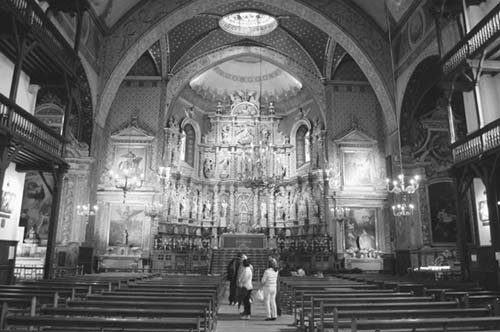
The three-foot-long paddle-wheel ship hanging in the center was a gift from Napoleon III’s wife, Eugènie. It’s a model of an ill-fated ship that had almost sunk just offshore when she was on it. The 1670 Baroque altar feels Franco-Spanish and features 20 French saints. Locals of this proud and rich town call it the finest in the Basque Country. The box seats across from the pulpit were reserved for leading citizens who were expected to be seen in church and set a good example. Today the mayor and city council members sit here on festival Sundays. The place has great acoustics, and the 17th-century organ is still used for concerts (around €10, mostly in summer, get schedule at TI or online at www.orgueluz.c.la, tickets available at door and possibly in advance at the TI).
As you leave the church, turn left to find the bricked-up doorway—the church’s original entrance. According to a quaint but untrue legend, it was sealed after the royal marriage (shown on the wall to the right in a photo of a painting) to symbolize a permanent closing of the door on troubles between France and Spain.
Hotels are a good value here. The higher prices are for peak season (generally July-Sept). In winter, some prices drop below those I’ve listed. Most hoteliers speak English, and breakfast is not included. Those wanting to eat and sleep for less will do slightly better just over the border, in San Sebastián.
$$$ Hôtel de la Plage*** has the best location, right on the ocean. Its 22 rooms, 16 with ocean views, have a lively yellow-and-blue modern nautical decor (Db-€89-119, ocean view Db-€119-169, family rooms for up to 5-€30 per extra person, breakfast-€11 but free for kids, air-con, elevator, free Wi-Fi, garage-€15, 33 Rue Garat, tel. 05 59 51 03 44, www.hoteldelaplage.com, reservation@hoteldelaplage.com, run by friendly Pierre, Laurent, and Frederic).
$$$ Hôtel Les Almadies***, on the main pedestrian street, is a bright boutique hotel with seven flawless rooms, comfy public spaces with clever modern touches, a pleasant breakfast room and lounge, an inviting sun deck, and a caring owner (Db-€100-135, higher prices are for rooms with tubs, buffet breakfast-€12, free Wi-Fi, parking-€10, 58 Rue Gambetta, tel. 05 59 85 34 48, www.hotel-les-almadies.com, hotel.lesalmadies@wanadoo.fr, Monsieur and Madame Hargous will charm you with their Franglish).
$$$ Hôtel Colbert***, a Best Western, has 34 modern, tastefully appointed rooms across the street from the train station (Sb-€80-133, Db-€96-162, extra bed-€15, family room-€241-339, breakfast-€14, air-con, elevator, free Wi-Fi, private parking-€20, 3 Boulevard du Commandant Passicot, tel. 05 59 26 31 99, www.hotelcolbertsaintjeandeluz.com, contact@hotelcolbertsaintjeandeluz.com).
$$ Hôtel Ohartzia** (“Souvenir”), one block off the beach, is comfortable, clean, and peaceful, with the most charming facade I’ve seen. It comes with 17 simple but well-cared-for rooms, generous and homey public spaces, and a delightful garden. Recently renovated, four rooms are 21st-century modern, and two have small, interior terraces. Higher prices are for the four rooms with tubs (mid-July-Sept Db-€85-91, March-mid-July Db-€75-79, Oct-Feb Db-€69-74, extra bed-€15, breakfast-€8, free Wi-Fi, 28 Rue Garat, tel. 05 59 26 00 06, www.hotel-ohartzia.com, hotel.ohartzia@wanadoo.fr). Their front desk is technically open only 8:00-21:00, but owners Madame and Monsieur Audibert (who speak little English) live in the building; their son Benoît speaks English well.
$$ Hôtel Le Petit Trianon**, on a major street a couple of blocks above the Old Town’s charm, is simple and traditional, with 25 tidy rooms and an accommodating staff (July-Sept Db-€88, Tb-€115, Qb-€150; April-June and Oct-mid-Nov Db-€73, Tb-€95, Qb-€120; even less off-season, air-con in most rooms, breakfast-€8, free Wi-Fi, limited parking-€10, 56 Boulevard Victor Hugo, tel. 05 59 26 11 90, www.hotel-lepetittrianon.com, lepetittrianon@wanadoo.fr). To get a room over the quieter courtyard, ask for côté cour (koh-tay koor).
St-Jean-de-Luz restaurants are known for offering good-value, high-quality cuisine. You can find a wide variety of eateries in the old center. For forgettable food with unforgettable views, choose from several places overlooking the beach. Most places serve from 12:15 to 14:00, and from 19:15 on.
The traffic-free Rue de la République, which runs from Place Louis XIV to the ocean promenade, is lined with hardworking restaurants (two of which are recommended below). Places are empty at 19:30, but packed at 20:30. Making a reservation, especially on weekends or in summer, is wise. Consider a fun night of bar-hopping for dinner in San Sebastián instead (an hour away in Spain, described on here).
La Ruelle serves good, traditionally Basque cuisine—mostly seafood—in a convivial dining room packed with tables, happy eaters, and kitschy Basque decor. André and his playful staff obviously enjoy their work, which gives this popular spot a relaxed and fun ambience. They offer a free sangria to diners with this book. Portions are huge; their €20 ttoro (seafood stew) easily feeds two—splitting is OK if you order two starters (€20-25 menus, closed Tue-Wed Oct-May, 19 Rue de la République, tel. 05 59 26 37 80).
Le Kaiku is the gastronomic experience in St-Jean-de-Luz. They serve modern, creatively presented cuisine, and specialize in wild seafood (rather than farmed). This dressy place is the most romantic in town, but manages not to be stuffy (€25 lunch menus, €30 dinner menus, closed Tue-Wed except July-Aug, 17 Rue de la République, tel. 05 59 26 13 20, www.kaiku.fr, Serge and Julie). For the best experience, talk with Serge about what you like best and your price limits (about €55 will get you a three-course meal à la carte without wine).
Chez Maya Petit Grill Basque serves hearty traditional Basque cuisine. Their €18 ttoro was a highlight of my day. They have €21 and €30 menus, but à la carte is more interesting. If you stick around in warm weather, you’ll see the clever overhead fan system kick into action (closed for lunch Mon and Thu and all day Wed, 2 Rue St. Jacques, tel. 05 59 26 80 76).
Zoko Moko offers Mediterranean nouvelle cuisine, with artistic creations on big plates. Get an amuse-bouche (an appetizer chosen by the chef) and a mignardise (a fun bite-sized dessert) with each main plate ordered (€25 lunchtime plats, €43 evening menu, closed Mon, Rue Mazarin 6, tel. 05 59 08 01 23, www.zoko-moko.com, owner Charles).
Fast and Cheap: Consider the take-away crêpe stands on Rue Gambetta. For a sit-down salad or a tart—either sweet or savory—consider Muscade Tarterie (€8-13 per slice; closed Mon; 20 Rue Garat, tel. 05 59 26 96 73).
Sweets: Maison Pariès is a favorite for its traditional sweets. Locals like their fine chocolates, tartes, macaroons, fudge (kanougas), and touron (like marzipan, but firmer), which comes in a multitude of flavors—brought by Jews who stopped here just over the border in 1492 after being expelled from Spain. The delectable chocolate version of the gâteau basque is also worth a try (9 Rue Gambetta, tel. 05 59 26 01 46).
The train station in St-Jean-de-Luz is called St-Jean-de-Luz-Ciboure. Its handy departure board displays lights next to any trains leaving that day. Buses leave from the green building across the street. There is reduced bus and rail service on Sundays and off-season.
From St-Jean-de-Luz by Train to: Bayonne (hourly, 25 minutes), St-Jean-Pied-de-Port (5/day, 6/day in summer, 2 hours with transfer in Bayonne), Paris (5/day direct via high-speed TGV, 5.5 hours; more with transfer in Bordeaux, 6 hours), Bordeaux (7/day, 2.5 hours), Sarlat (1/day, 2/day on weekends, 6-8 hours, transfer in Bordeaux), Carcassonne (1/day, 5 hours, transfers likely in Bayonne and Toulouse).
By Train to San Sebastián: First, take the 10-minute train to the French border town of Hendaye (Gare SNCF stop, about 10/day). Or get to Hendaye by bus (3/day, 35 minutes); check the schedule to see which leaves first.
Leave the Hendaye SNCF train station to the right, and look for the small building on the same side of the street, where you’ll catch the commuter EuskoTren into San Sebastián (usually 4/hour Mon-Fri, 2/hour Sat-Sun, runs 7:00-22:33, 35 minutes). Locals call this line the Topo (“Mole”), since part of it runs underground—although officially, it’s part of the new Metro Donostialdea system for San Sebastián.
By Bus: Buses leave from the bus station directly in front of the train station (cross the road by using the pedestrian underpass). All tickets are bought on the bus. Local ATCRB bus #816 connects St-Jean-de-Luz either to Bayonne or Biarritz almost hourly. Confusingly, this one bus can run two different routes (one to Bayonne, the other to Biarritz Centre, 45 minutes to either one)—check the destination carefully. Bus #24 connects St-Jean-de-Luz to Sare (Mon-Fri 6/day, Sat 2/day, none Sun, 30 minutes, tel. 09 70 80 90 74, www.transports-atcrb.com). A Spanish Pesa bus runs to San Sebastián (Mon-Sat only, 2/day direct—likely at 12:45 and 19:15, none on Sun, 1 hour, only 1/week off-season, info in Spain tel. 902-101-210, www.pesa.net).
By Excursion: If you’re without a car, consider using Le Basque Bondissant’s day-trip excursions to visit otherwise difficult-to-reach destinations, such as the Guggenheim Bilbao (see “Tours in St-Jean-de-Luz,” earlier).
By Taxi to San Sebastián: This will cost you about €75 for up to four people, but it’s convenient (tel. 05 59 26 10 11 or mobile 06 25 76 97 69).
A one-day side-trip to both Bayonne and Biarritz is easy from St-Jean-de-Luz. These three towns form a sort of triangle (depending on traffic, each one is less than a 30-minute drive from the other). Hop on the autoroute to Bayonne, sightsee there, then take D-810 into Biarritz. Leaving Biarritz, continue along the coastal D-810. In Bidart, watch (on the right) for the town’s proud frontón (pelota court) and stop for a photo of the quaint town hall. Consider peeling off to go into the village center of Guéthary, with another frontón and a massive town hall. If you’re up for a walk on the beach, cross the little bridge in Guéthary, park by the train station, and hike down to the walkway along the surfing beach (lined with cafés and eateries). When you’re ready to move on, you’re a very short drive from St-Jean-de-Luz.
To feel the urban pulse of French Basque Country, visit Bayonne—modestly but honestly nicknamed “your anchor in the Basque Country” by its tourist board. With frequent, fast train and bus connections with St-Jean-de-Luz, Bayonne makes an easy half-day side-trip.
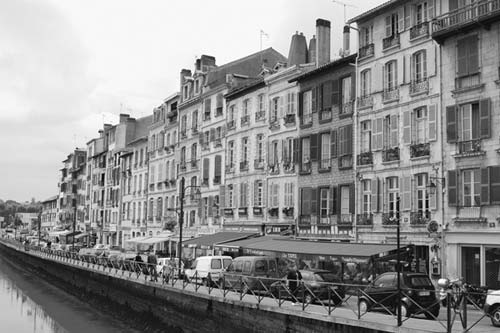
Come here to browse through Bayonne’s atmospheric and well-worn-yet-lively Old Town, and to admire its impressive Museum of Basque Culture. Known for establishing Europe’s first whaling industry and for inventing the bayonet, Bayonne is more famous today for its ham (jambon de Bayonne) and chocolate.
Get lost in Bayonne’s Old Town. In pretty Grand Bayonne, tall, slender buildings, decorated in Basque fashion with green-and-red shutters, climb above cobbled streets. Be sure to stroll the streets around the cathedral and along the banks of the smaller Nive River, where you’ll find the market (Les Halles).
Bayonne’s two rivers, the grand Adour and the petite Nive, divide the city into three parts: St-Esprit, with the train station; and the more interesting Grand Bayonne and Petit Bayonne, which together make up the Old Town.
The TI is in a modern parking lot a block off the mighty Adour River, on the northeastern edge of Grand Bayonne. They have very little in English other than a map and a town brochure (July-Aug Mon-Sat 9:00-19:00, Sun 10:00-18:00; March-June and Sept-Oct Mon-Fri 9:00-18:30, Sat 10:00-18:00, closed Sun; shorter hours in off-season; Place des Basques, tel. 08 20 42 64 64, www.bayonne-tourisme.com). There’s a pay WC in the rear.
By Train: The TI and Grand Bayonne are a 15-minute walk from the train station: Walk straight out of the station, cross the parking lot and traffic circle, and then cross the imposing bridge (Pont St. Esprit). Once past the big Adour River, continue across a smaller bridge (Pont Mayou), which spans the smaller Nive River. Stop on Pont Mayou to orient yourself: You just left Petit Bayonne (left side of Nive River); ahead of you is Grand Bayonne (spires of cathedral straight ahead, TI a few blocks to the right). The Museum of Basque Culture is in Petit Bayonne, facing the next bridge up the Nive River.
By Car or Bus: The handiest parking is also where buses arrive in Bayonne: next to the TI at the modern parking lot on the edge of Grand Bayonne. To reach the town center from here, walk past the war memorial and through the break in the ramparts. Follow the walkway until you reach a fancy gate that leads through a tunnel. After the tunnel, turn right at the next street; the cathedral should immediately come into view. Continue behind the cathedral and walk down, down, down any of the atmospheric streets to find Les Halles (the market) and the Nive River.
To reach this parking lot, drivers take the Bayonne Sud exit from the autoroute, then follow green Bayonne Centre signs, then white Centre-Ville signs (with an i for tourist information). You’ll see the lot on your right. Payment machines only accept coins for a maximum of two hours. In high season, when this lot can be full, use one of the lots just outside the center (follow signs to Glain or Porte d’Espagne as you arrive in town), then catch the little orange navette (shuttle bus) to get into the center (free, find route maps posted at stops in town, every 7 minutes, Mon-Sat 7:30-19:30, closed Sun).
Loaner Bikes: Although Bayonne’s sights are easily reached on foot (except the chocolate workshop), pedaling about by bike is simple and relaxing. The TI lends a limited number of orange bikes for free to adults during office hours (must leave passport or driver’s license and a €150 deposit, same hours and contact information as TI, www.cyclocom.fr).
Laundry: Laverie is just blocks from the cathedral (self-service €4/wash, daily 8:00-20:00, 6 Rue d’Espagne, tel. 05 59 59 54 03).
This museum (in Petit Bayonne, facing the Nive River at Pont Marengo) explains French Basque culture from cradle to grave—in French, Euskara, and Spanish. The only English you’ll read is “do not touch” (unless you buy their informative €5 English booklet). Artifacts and videos take you into traditional Basque villages and sit you in the front row of time-honored festivals, letting you envision this otherwise hard-to-experience culture.
Cost and Hours: €6.50, free first Sun of month; open July-Sept daily 10:00-18:30, Thu until 20:30; Oct-June Tue-Sun 10:00-18:30, closed Mon; last entry one hour before closing, 37 Quai des Corsaires, tel. 05 59 59 08 98, www.musee-basque.com.
Visiting the Museum: On the ground floor, you’ll begin with a display of carts and tools used in rural life, then continue past some 16th-century gravestones. Look for the laiak—distinctive forked hoes used to work the ground. At the end of this section you’ll watch a grainy film on Basque rural lifestyles.
The next floor up begins by explaining that the house (etxea) is the building block of Basque society. More than just a building, it’s a social institution—Basques are named for their house, not vice versa. You’ll see models and paintings of Basque houses, then domestic items, a giant door, kitchen equipment, and furniture (including a combination bench-table, next to the fireplace). After an exhibit on Basque clothing, you’ll move into the nautical life, with models, paintings, and actual boats. The little door leads to a large model of the port of Bayonne in 1805, back when it was a strategic walled city.
Upstairs you’ll learn that the religious life of the Basques was strongly influenced by the Camino de Santiago pilgrim trail, which passes through their territory. One somber room explains Basque funeral traditions. The section on social life includes a video of Basque dances (typically accompanied by flute and drums). These are improvised, but according to a clearly outlined structure—not unlike a square dance.
The prominence given to the sport of pelota (see sidebar on here) indicates its importance to these people. One dimly lit room shows off several types of txistera baskets (chistera in French), gloves, and balls used for the game; videos show you how these items are made. The museum wraps up with a brief lesson on the region’s history from the 16th to the 20th centuries, including exhibits on the large Jewish population here (who had fled from a hostile Spain) and the renaissance of Basque culture in the 19th century.
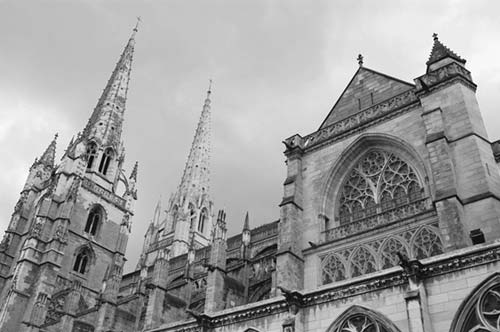
Bankrolled by the whaling community, this cathedral sits dead-center in Grand Bayonne and is worth a peek. Find the unique keystones on the ceiling along the nave, then circle behind the church to find the peaceful and polished 13th-century cloisters.
Cost and Hours: Cathedral—free, Mon-Sat 10:00-11:45 & 15:00-17:45, Sun 15:30-18:00; cloisters—free, daily 9:00-12:30 & 14:00-17:00, until 18:00 mid-May-mid-Sept.
With no more whales to catch, Bayonne turned to producing mouthwatering chocolates and marzipan; look for shops on the arcaded Rue du Port Neuf (running between the cathedral and the Adour River). Daranatz is Bayonne’s best chocolate shop, with bars of chocolate blended with all kinds of flavors—one with a general mix of spices (lots of cardamom), one with just cinnamon, and another with piments d’Espelette (15 Arceaux Port Neuf, tel. 05 59 59 03 55, www.chocolat-bayonne-daranatz.fr). Cazenave, founded in 1854, is a fancy chocolaterie with a small café in the back. Try their foamy hot chocolate with fresh whipped cream on the side, served with buttered toast for €9 (Tue-Sat 9:00-12:00 & 14:00-19:00, closed Sun-Mon, 19 Arceaux Port Neuf, tel. 05 59 59 03 16, www.chocolats-cazenave.fr).
L’Atelier du Chocolat is a chocolate factory and boutique in an industrial part of town. You’ll see a detailed exhibit on the history and making of chocolate, some workers making luscious goodies (9:30-11:00 only), and a video. The generous chocolate tasting at the end is worth the ticket price for chocoholics.
Cost and Hours: €5.80, Mon-Sat 9:30-12:30 & 14:00-18:00, closed Sun, last entry 1.5 hours before closing, 7 Allée de Gibéléou, tel. 05 59 55 70 23, www.atelierduchocolat.fr.
Getting There: Take city bus #A2 from the TI or the Mairie stop across from the town hall (buy €1 ticket on board), get off at the Jean-Jaurès stop, walk under the railway bridge past the roundabout, and follow signs.
The ramparts around Grand Bayonne are open for walking and great for picnicking (access from park at far end of TI parking lot). However, the ramparts do not allow access to either of Bayonne’s castles—both are closed to the public.
(€1 = about $1.30, country code: 33)
$$$ Le Grand Hôtel*** is the best of the limited options in Bayonne—it’s well-located in Grand Bayonne, with all the comforts and a pleasant staff. While renovating their old building, the owners took care to maintain the original, classic decor (Sb-€75-160, Db-€81-166, breakfast-€13, elevator, free Wi-Fi, parking-€13, 21 Rue Thiers, tel. 05 59 59 62 00, www.bw-legrandhotel.com, infos@bw-legrandhotel.com, Caroline).
$$$ Ibis Styles Bayonne Gare Centre*** sits next to the Pont Saint Esprit near the train station. Some of its 45 white, bright rooms overlook the river (Sb-€86-116, Db-€96-135, Tb-€99-145, includes breakfast, elevator, parking-€8, 1 Place de la République, tel. 05 59 55 08 08, www.ibis.com, h8716@accor.com).
$$ Hôtel Côte Basque** is conveniently located by the train station in the Saint Esprit neighborhood, just across the river from the Old Town. It’s on a busy street, but the small-but-comfortable rooms have double-paned windows to cut the noise (Sb-€61-66, Db-€64-69, Tb-€71-76, breakfast-€10, elevator, free Wi-Fi, 2 Rue Maubec, tel. 05 59 55 10 21, www.hotel-cotebasque.fr, hotelcotebasque@orange.fr).
$$ Hôtel des Arceaux** is a family-run B&B-style establishment with 16 rooms on a small pedestrian street in Grand Bayonne. It’s just around the corner from the cathedral (Db-€66-76, breakfast-€7, free Wi-Fi, 26 Rue Port Neuf, tel. 05 59 59 15 53, www.hotel-arceaux.com, hotel.arceaux@wanadoo.fr).
The Grand Bayonne riverside has several tapas restaurants, a couple of easy bistrots, and a pizza place. The Petit Bayonne riverside has some bistrots and a few more proper sit-down restaurants. The pedestrian streets surrounding the cathedral in Grand Bayonne offer casual dining spots serving crêpes, tartines, quiches, and salads. Most places have outdoor tables in nice weather.
Le Bayonnais, next door to the Museum of Basque Culture, serves traditional Basque specialties à la carte. Sit in the blue-tiled interior or out along the river (€18 weekday lunch and dinner menu on weekdays, closed Sun-Mon, Quai des Corsaires 38, tel. 05 59 25 61 19).
La Cidrerie Txotx (pronounced “choch”) has a Spanish-bodega ambience under a chorus line of hams. You can also sit outside, along the river, just past the market hall (€8-10 Basque tapas or €12-19 plats, daily, 49 Quai Jauréguiberry, tel. 05 59 59 16 80).
A la Bolée serves up inexpensive sweet and savory crêpes in a cozy atmosphere along the side of the cathedral (daily, 10 Place Pasteur, tel. 05 59 59 18 75).
Le Chistera, run by a family that’s spent time in the US, proudly serves traditional Basque dishes made with market-fresh ingredients. Try the poulet with Basque sauce or one of their soups, and polish off your meal with homemade gâteau basque (€16 lunch menu, €25-30 dinners, Tue-Wed 12:00-14:00, Thu-Sun 12:00-14:00 & 19:30-21:00, closed Mon, 42 Rue Port Neuf, tel. 05 59 59 25 93, www.lechistera.com).
Café du Théâtre has pleasant outdoor tables by the river. Try it for a simple early breakfast (Place de la Liberté, tel. 05 59 59 09 31).
Picnic Supplies: If the weather’s good, consider gathering a picnic from the shops along the pedestrian streets, at Les Halles market (only open in the mornings), in the Casino minimart (Mon-Sat 8:00-13:00 & 15:30-20:00, closed Sun, 38 Rue Port Neuf), or at the Monoprix (Mon-Sat 8:30-20:30, closed Sun, 8 Rue Orbe). Don’t forget the chocolate, then head for the park around the ramparts below the Jardin Botanique (benches galore).
Chronoplus buses run throughout the area regularly. Most lines run two to three times an hour from about 7:00 to 20:00, but are noticeably less frequent on Saturdays and even sparser on Sundays. Buy a €1 ticket on the bus; if you plan to ride twice or more in one day, buy the 24-hour ticket for €2 (tel. 05 59 52 59 52, www.chronoplus.eu).
From Bayonne by Bus to: BAB (Biarritz-Anglet-Bayonne) Airport (2-3/hour, 15 minutes, line #C is best option), Biarritz (2-3/hour, fewer on Sun, 30 minutes, Chronoplus lines #A1 and #A2), and St-Jean-de-Luz (almost hourly, 45 minutes, ATCRB line #816, €3). Pick up BAB and Biarritz buses by the Mairie/Théâter stop on the riverside; catch the St-Jean-de-Luz bus from Place des Basques by the TI. Buses to the inland Basque villages of Espelette and Ainhoa are impractical.
By Train to: St-Jean-Pied-du-Port (5/day, 6/day in summer, 1.25 hours).
By Taxi to: Biarritz (20 minutes, about €30) and St-Jean-de-Luz (30 minutes, about €50—or more if traffic is heavy, tel. 05 59 59 48 48).
A glitzy resort town steeped in the belle époque, Biarritz (bee-ah-ritz) is where the French Basques put on the ritz. In the 19th century, this simple whaling harbor became, almost overnight, a high-class aristocrat-magnet dubbed the “beach of kings.” Although St-Jean-de-Luz and Bayonne are more fully French and more fully Basque, the made-for-international-tourists, jet-set scene of Biarritz is not without its charms. Perched over a popular surfing beach, anchored by grand hotels and casinos, hemmed in by jagged and picturesque rocky islets at either end, and watched over by a lighthouse on a distant promontory, Biarritz is a striking beach resort. However, for sightseers with limited time, it’s likely more trouble than it’s worth.
Biarritz feels much bigger than its population of 30,000. The town sprawls, but virtually everything we’re interested in lines up along the waterfront: the beach, the promenade, the hotel and shopping zone, and the TI.
The TI is in a little pink castle two blocks up from the beach (just above the beach and casino, hiding behind the City Hall—look for hôtel de ville signs). Pick up the free map and get details on any sightseeing that interests you (July-Aug daily 9:00-19:00; Sept-June Mon-Fri 9:00-18:00, Sat-Sun 10:00-17:00; Square d’Ixelles, tel. 05 59 22 37 00, www.biarritz.fr).
By Car: Drivers follow signs for Centre-Ville, then carefully track signs for specific parking garages. The most central garages are called Grande Plage, Casino, Bellevue, and St. Eugénie (closest to the water). Signs in front of each tell you whether it’s full (complet), in which case move on to the next one.
By Bus: Buses stop at “Biarritz Centre,” a parking lot next to the TI (buses to/from Bayonne stop along the side of the lot; buses to/from St-Jean-de-Luz stop at the end of the lot). If you’re taking a bus, be aware that some stop at the outskirts of town—only take one to “Centre.”
Don’t bother taking the train to or from Biarritz, as the station is about two miles from the tourist area (but if you must, bus #A1 connects the train station to the city center hourly, €1, buy ticket from driver).
There is no baggage storage in Biarritz.
There’s little of sightseeing value in Biarritz. The TI can fill you in on the town’s four museums (Marine Museum—described below; Chocolate Planet and Museum—intriguing, but a long walk from the center; Oriental Art Museum—large, diverse collection of art from across Asia; and Biarritz Historical Museum—really?).
Your time is best spent strolling along the various levels that climb up from the sea. (Resist the urge to check out the pebble beach for now.) From the TI, you can do a loop: First head west on the lively pedestrian streets that occupy the plateau above the water, which are lined with restaurants, cafés, and high-class, resorty window-shopping. (Place Georges Clemenceau is the grassy “main square” of this area.) Biarritz is picnic-friendly, with beaucoup benches facing the waves. Consider stocking up before continuing this walk.
Work your way past the Église Sainte Eugénie out to the point with the Marine Museum (Musée de la Mer). The most convenient of Biarritz’s attractions, this pricey Art Deco museum/aquarium wins the “best rainy-day option” award, with a tank of seals and a chance to get face-to-teeth with live sharks (€13.50, daily 9:30-20:00, July-Aug until 24:00, last entry one hour before closing, tel. 05 59 22 75 40, www.museedelamer.com).
Whether or not you’re visiting the museum, it’s worth hiking down to the entrance, then wandering out on the walkways that connect the big offshore rocks. These lead to the so-called Virgin Rock (Rocher de la Vierge), topped by a statue of Mary. Spot any surfers?
From here, stick along the water as you head back toward the TI. After a bit of up and down over the rocks, don’t miss the trail down to Fishermen’s Wharf (Port des Pêcheurs), a little pocket of salty authenticity that clings like barnacles to the cliff below the hotels. The remnants of an aborted construction project from the town’s glory days, this little fishing settlement of humble houses and rugged jetties seems to faintly echo the Basque culture that thrived here before the glitz hit. Many of the houses have been taken over by the tourist trade (gift shops and restaurants).
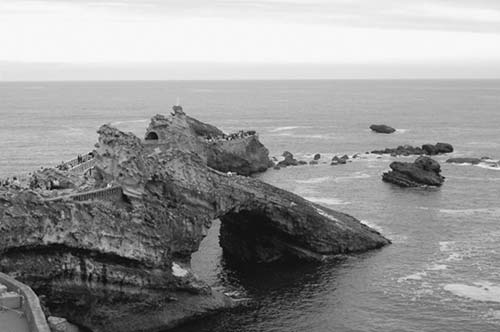
Continuing along the water (and briefly back up to street level), make your way back to the town’s centerpiece, the big beach (Grande Plage). Dominating this inviting stretch of sand is the Art Deco casino, and the TI is just above that. If you haven’t yet taken the time on your vacation to splash, wade, or stroll on the beach...now’s your chance.
From Biarritz by Bus to: St-Jean-de-Luz (nearly hourly, fewer on Sundays, 45 minutes, ATCRB line #816) and Bayonne (2-3/hour, fewer on Sundays, 30 minutes, Chronoplus lines #A1 and #A2).
Traditional villages among the green hills, with buildings colored like the Basque flag, offer the best glimpse of Basque culture. Cheese, hard cider, and pelota players are the primary products of these villages, which attract few foreigners but many French summer visitors. Most of these villages have welcomed pilgrims bound for Santiago de Compostela since the Middle Ages. Today’s hikers trek between local villages or head into the Pyrenees. The most appealing villages lie in the foothills of the Pyrenees, spared from beach-scene development.
Use St-Jean-de-Luz as your base to visit the Basque sights described below. You can reach some of these places by public transportation, but the hassle outweighs the rewards. Do a circuit of these towns in the order they’re listed here. Assuming you’re driving, I’ve included route instructions as well.
• Only 15 minutes from St-Jean-de-Luz, follow signs for Ascain, then Sare. On the twisty-turny road toward Sare, you’ll pass the station for the train up to...
Between the villages of Ascain and Sare, near the border with Spain, a small cogwheel train takes tourists to the top of La Rhune, the region’s highest peak (2,969 feet). You’ll putt-putt up the hillside for 35 minutes in a wooden, open-air train car to reach panoramic views of land and sea (adults-€15 round-trip, kids-€8, all pay €2-3 more in summer, runs March-mid-Nov daily, closed mid-Nov-Feb, departures weather-dependent—the trip is worthless if it’s not clear, goes every 35 minutes when busiest July-Aug, tel. 05 59 54 20 26, www.rhune.com). For those traveling without a car, La Basque Bondissant runs a shuttle for peak-season tourists from St-Jean-de-Luz (€17, kids-€10, train ticket included, see here).
• Continue along the same road, and look out for pull-offs with room for a couple of cars, typically placed at the most scenic spots. Stop to smell the grass before the next stop...
Sare, which sits at the base of the towering mountain La Rhune, is among the most picturesque villages—and the most touristed. It’s easily reached from St-Jean-de-Luz by bus or car. The small TI is on the main square (Mon-Fri 9:30-12:30 & 13:30-18:00, Sat 9:30-12:30, closed Sun year-round and Sat Nov-March, tel. 05 59 54 20 14, www.sare.fr). Nearby is a cluster of hotels and the town church (which has an impressive interior, with arches over the gold-slathered altar and Basque-style balconies lining the nave). Reforms in the 18th century prohibited burials at or near Catholic churches, but Basque-style tombstones still surround the main church. At the far end of the square is the town’s humble frontón (pelota court).
• Leaving Sare, first follow signs for toutes directions, then St-Pée, and watch for the turnoff to...
Ainhoa is a colorful, tidy, picturesque one-street town that sees fewer tourists (which is a good thing). Its chunks of old walls and gates mingle with red-and-white half-timbered buildings. The 14th-century church—with a beautiful golden retable (screen behind the altar)—and the frontón share center stage. Parking is plentiful; resist the urge to turn off at the frontón—it’s better to continue on for parking near the TI.
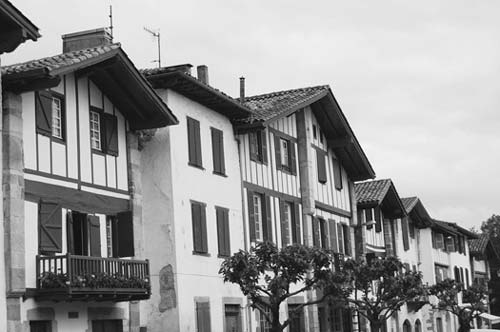
Ainhoa is also a popular starting point for hikes into the hills. For a spectacular village-and-valleys view, drive five minutes (or walk 90 sweaty minutes) up the steep dirt road to the Chapelle de Notre-Dame d’Aranazau (“d’Aubepine” in French). Start in the central parking lot directly across the main street from the church, then head straight uphill into the clouds. Follow signs for oratoire, then count the giant white crosses leading the way to the top. The chapel is occasionally closed, and cloudy days don’t offer spectacular views, but the ethereal experience is worth the steep detour for drivers.
• As you leave Ainhoa, you’ll have to backtrack the way you came in to find the road to...
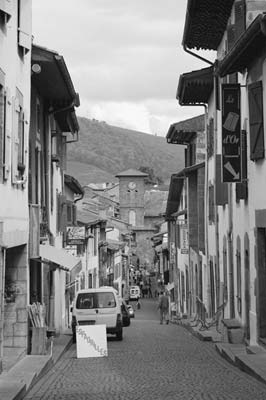
Espelette won’t let you forget that it’s the capital of the region’s AOC red peppers (piments d’Espelette), with strands of them dangling like good-luck charms from many houses and storefronts. After strolling the charming, cobbled center, head to the well-restored château and medieval tower of former local barons, which now houses the town hall, exhibition space, and the TI (Mon-Fri 8:30-12:30 & 14:00-18:00, Sat 9:30-12:30, closed Sun, tel. 05 59 93 95 02, www.espelette.fr). Or wander downhill toward the pink frontón, following the église signs past houses constructed in the 1700s and a captivating stream, to find the town church. Climb up into the church balconies for some fancy views.
Sleeping and Eating: For a good regional meal, consider the $$ Hôtel Euzkadi** restaurant, with a muy Spanish ambience (€18-36 menus, daily 12:30-14:00 & 19:30-21:00, July-Aug closed Mon, Sept-June closed Mon-Tue, 285 Karrika Nagusia, tel. 05 59 93 91 88). The hotel has 27 rooms with modern touches and a swimming pool (Db-€78-84, air-con, elevator, free Wi-Fi, www.hotel-restaurant-euzkadi.com).
• From Espelette, if you have time, you can follow signs to Cambo les Bains, then St-Jean-Pied-de-Port (40 minutes).
Just five miles from the Spanish border, the walled town of St-Jean-Pied-de-Port (san-zhahn-pee-ay-duh-por) is the most popular village in all the French Basque countryside (you may also see it labeled as Donibane Garazi, its Basque name). Traditionally, St-Jean-Pied-de-Port has been the final stopover in France for pilgrims undertaking the Camino de Santiago (“Way of Saint James”)—the medieval pilgrimage route that runs from here 500 miles across the north of Spain to the city of Santiago de Compostela. After centuries of obscurity, the pilgrimage has become more popular again recently, as thousands of modern travelers each year follow that ancient trail on foot, bike, or horseback. From St-Jean-Pied-de-Port, Santiago-bound pilgrims cross the Pyrenees together and continue their march through Spain. The scallop shell of “St. Jacques” (French for “James”) is etched on walls throughout the town.
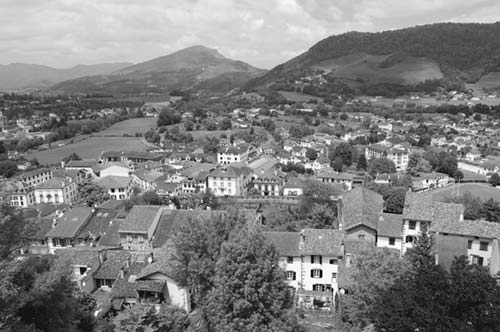
About half the visitors to this town are pilgrims; the rest are mostly French tourists. Gift shops sell a strange combination of pilgrim gear (such as quick-drying shirts and shorts) and Basque souvenirs. This place is packed in the summer (so come early or late).
Tourist Information: The TI, on the main road along the outside of the walled Old Town, can give you a town map (Mon-Sat 9:00-12:00 & 14:00-18:00, closed Sun, tel. 05 59 37 03 57). For Camino information, you’ll do better at the Pilgrim Friends Office (described on the next page). Ask the TI about weekly pelota vasca games (usually Mon at 16:00 or 17:00 at the trinquet court on Place du Trinquet).
Arrival in St-Jean-Pied-de-Port: Parking is ample and well-signed from the main road. If arriving by train, exit the station to the left, then follow the busy road at the traffic circle toward the city wall.
Sights: There’s little in the way of sightseeing here, other than pilgrim-spotting. But St-Jean-Pied-de-Port feels like the perfect “Welcome to the Camino” springboard for the upcoming journey. Many modern pilgrims begin their Camino in this traditional spot because of its easy train connection to Bayonne, and because—as its name implies (“St. John at the Foot of the Pass”)—it offers a very challenging but rewarding first leg: up, over, and into Spain.
Enter the Old Town on restaurant row, Rue d’Uhart, then turn left onto Rue d’Espagne. The Notre-Dame Gate, which was once a drawbridge, is straight ahead. Cross the old bridge over the Nive River (the same one that winds up in Bayonne) and head up the main walking drag, Rue de la Citadelle. With its rosy-pink buildings and the ancient dates above its doorways, this lane simply feels old. Notice lots of signs for chambres (rooms) and refuges—humble, hostel-like pilgrim bunkhouses.
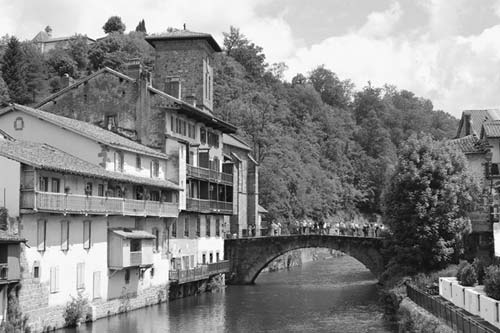
Partway up, on the left at #39, look for the Pilgrim Friends Office (Les Amis du Chemin de Saint-Jacques, daily 7:30-11:45 & 13:00-18:45 & 19:45-22:00, tel. 05 59 37 05 09). This is where pilgrims check in before their long journey to Santiago; about 46,000 pilgrims started out here in 2012 (compared with just 4,000 about a decade ago).
Where do they all come from? In 2012, about 9,000 French pilgrims set out here. The second largest group hailed from Spain (7,300), with Italy and Germany following. The US came in fifth, with almost 3,000 pilgrims. For €2, a pilgrim can buy the official credential (credenciel in French, credencial in Spanish) that she’ll get stamped at each stop between here and Santiago to prove she walked the whole way and thereby earn her compostela certificate. Pilgrims also receive a warm welcome, lots of advice (like a handy chart breaking down the walk into 34 stages, with valuable distance and elevation information), and help finding a bunk (the well-traveled staff swears that no pilgrim ever goes without a bed in St-Jean-Pied-de-Port).
A few more steps up, on the left, you’ll pass the skippable €3 Bishop’s Prison (Prison des Evêques). Continue on up to the citadel, dating from the mid-17th century—when this was a highly strategic location, keeping an eye on the easiest road over the Pyrenees between Spain and France. Although not open to the public (as it houses a school), the grounds around this stout fortress offer sweeping views over the French Basque countryside.
Sleeping in St-Jean-Pied-de-Port: Lots of humble pilgrim lodgings line the main drag, Rue de la Citadelle. If you’re looking for a bit more comfort, consider these options.
$$ Hotel Ramuntcho** is the only real hotel option in the Old Town, located partway up Rue de la Citadelle. Its 16 rooms above a restaurant are straightforward but modern (Db-€67-81, breakfast-€9, free Wi-Fi, 1 Rue de France, tel. 05 59 37 03 91, http://hotel-ramuntcho.com, hotel.ramuntcho@wanadoo.fr).
$$ Itzalpea, a café and tea house, rents five rooms along the main road just outside the Old Town (Sb-€55-58, Db-€65-78 depending on size, includes breakfast, closed Sat off-season, air-con, 5 Place du Trinquet, tel. 05 59 37 03 66, www.maisondhotes-itzalpea.com, itzalpea@wanadoo.fr).
$ Chambres Chez l’Habitant has five old-fashioned, pilgrim-perfect rooms along the main drag. Welcoming Maria and Jean Pierre speak limited English, but their daughter can help translate (€20-25 per person in D, Db, Q, or Qb, includes breakfast, 15 Rue de la Citadelle, tel. 05 59 37 05 83, www.chambres-camino.com).
Eating in St-Jean-Pied-de-Port: Tourists, pilgrims, and locals alike find plenty of places to eat along Rue de la Citadelle (heading up to the citadel), Rue du Trinquet (the main traffic street into town), and Rue d’Uhart. Consider Café Navarre (1 Place Juan de Huarte, tel. 05 59 37 01 67) or Cafe Ttipia (2 Place Charles Floquet, tel. 05 59 37 11 96). If you want to picnic and are lucky enough to land here on a Monday morning, shop at the weekly market. Farmers, cheesemakers, and winemakers bring their products in from the countryside.
St-Jean-Pied-de-Port Connections: A scenic train conveniently links St-Jean-Pied-de-Port to Bayonne (5/day, 6/day in summer, 1.25 hours) and from there to St-Jean-de-Luz (about 25 minutes beyond Bayonne, www.sncf.fr). It’s about a 1.25-hour drive from St-Jean-de-Luz.
Four of the seven Basque territories lie within Spain. Many consider Spanish Basque culture to be feistier and more colorful than the relatively assimilated French Basques—you’ll hear more Euskara spoken here than in France.
For nearly 40 years, beginning in 1939, the figure of Generalísimo Franco loomed large over the Spanish Basques. Franco depended upon Basque industry to keep the floundering Spanish economy afloat. But even as he exploited the Basques economically, he so effectively blunted Basque culture that the language was primarily Spanish by default. Franco kicked off his regime by offering up the historic Basque town of Guernica as target practice to Hitler’s air force. The notorious result—the wholesale slaughter of innocent civilians—was immortalized by Pablo Picasso’s mural Guernica.
But Franco is long gone, and today’s Basques are looking to the future. The iron deposits have been depleted, prompting the Basques to re-imagine their rusting cities for the 21st century. True to form, they’re rising to the challenge. Perhaps the best example is Bilbao, whose iconic Guggenheim Museum—built on the former site of an industrial wasteland—is the centerpiece of a bold new skyline.
San Sebastián is the heart of the tourist’s País Vasco, with its sparkling, picturesque beach framed by looming green mountains and a charming Old Town with gourmet pintxos (tapas) spilling out of every bar. On-the-rise Bilbao is worth a look for its landmark Guggenheim and its atmospheric Old Town. For small-town fun, drop by the fishing village of Lekeitio (near Bilbao). And for history, Guernica has some intriguing museums.
Shimmering above the breathtaking Concha Bay, elegant and prosperous San Sebastián (Donostia in Euskara, which locals lovingly shorten to Donosti) has a favored location with golden beaches, capped by twin peaks at either end, and with a cute little island in the center. A delightful beachfront promenade runs the length of the bay, with an intriguing Old Town at one end and a smart shopping district in the center. It has 186,000 residents and almost that many tourists in high season (July-Sept). With a romantic setting, a soaring statue of Christ gazing over the city, and a late-night lively Old Town, San Sebastián has a mini-Rio de Janeiro aura. Though the actual “sightseeing” isn’t much, the scenic city itself provides a pleasant introduction to Spain’s Basque Country. And as a culinary capital of Spain—with many local restaurants getting international attention—competition is tight to dish up some of the top tapas anywhere.
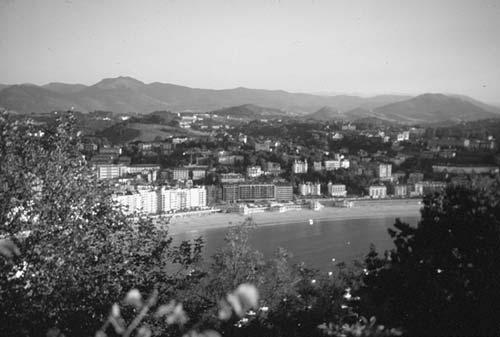
In 1845, Queen Isabel II’s doctor recommended she treat her skin problems by bathing in the sea here. (For modesty’s sake, she would go inside a giant cabana that could be wheeled into the surf—allowing her to swim far from prying eyes, never having to set foot on the beach.) Her visit mobilized Spain’s aristocracy, and soon the city was on the map as a seaside resort. By the turn of the 20th century, San Sebastián was the toast of the belle époque, and a leading resort for Europe’s beautiful people. Before World War I, Queen María Cristina summered here and held court in her Miramar Palace overlooking the crescent beach (the turreted, red-brick building partway around the bay). Hotels, casinos, and theaters flourished. Even Franco enjoyed 35 summers in a place he was sure to call San Sebastián, not Donostia.
San Sebastián’s sights can be exhausted in a few hours, but it’s a great place to be on vacation for a full, lazy day (or longer). Stroll the two-mile-long promenade with the locals and scout the place you’ll grab to work on a tan. The promenade leads to a funicular that lifts you to the Monte Igueldo viewpoint. After exploring the Old Town and port, walk up to the hill of Monte Urgull. If you have more time, enjoy the delightful aquarium. Museum-goers find it worthwhile to visit the Museum of San Telmo, the largest of its kind on Basque culture. A key ingredient of any visit to San Sebastián is enjoying tapas in the Old Town bars.
The San Sebastián that we’re interested in surrounds Concha Bay (Bahía de la Concha). It can be divided into three areas: Playa de la Concha (best beaches), the shopping district (called Centro), and the skinny streets of the grid-planned Old Town (called Parte Vieja, to the north of the shopping district). Centro, just east of Playa de la Concha, has beautiful turn-of-the-20th-century architecture, but no real sights. A busy drag called Alameda del Boulevard (or just “Boulevard”) stands where the city wall once ran, and separates the Centro from the Old Town.
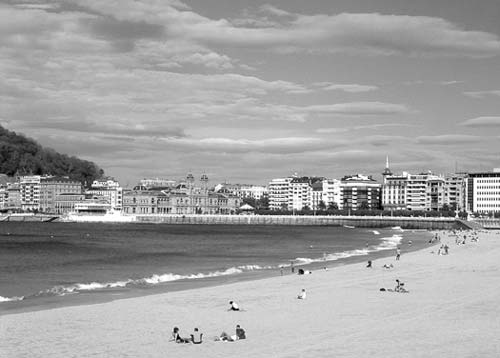
It’s all bookended by mini-mountains: Monte Urgull to the north and east, and Monte Igueldo to the south and west. The river (Río Urumea) divides central San Sebastián from the district called Gros, with a lively night scene and surfing beach.
San Sebastián’s TI, conveniently located right on the Boulevard, has information on city and regional sights, bike rentals (see “Helpful Hints,” later), and bus and train schedules. Pick up the free map and various pamphlets with English descriptions of three self-guided walking tours—the Old Town/Monte Urgull walk is best. The TI also offers guided walking tours—see here (July-Sept Mon-Sat 9:00-20:00, Sun 10:00-19:00; Oct-June Mon-Thu 9:00-13:30 & 15:30-19:00, Fri-Sat 10:00-19:00, Sun 10:00-14:00; Boulevard 8, tel. 943-481-166, www.sansebastianturismo.com).
By Train: The town has two train stations (neither has luggage storage, but you can leave bags at Navi.net Internet café downtown—see “Helpful Hints,” later).
If you’re coming on a regional train from Hendaye/Hendaia on the French border, get off at the Amara EuskoTren Station (five stops before the end of the line, which is called Lasarte-Oria). It’s a level 15-minute walk to the center: Exit the station and walk across the long plaza, then veer right and walk eight blocks down Calle Easo (toward the statue of Christ hovering on the hill) to the beach. The Old Town will be ahead on your right, with Playa de la Concha to your left. To speed things up, catch bus #21, #26, or #28 along Calle Easo and take it to the Boulevard stop, near the TI at the bottom of the Old Town.
If you’re arriving by train from elsewhere in Spain (or from France after transferring in Irún), you’ll get off at the main RENFE station. It’s just across the river from the Centro shopping district. There are no convenient buses from the station—to get to the Old Town and most recommended hotels, catch a taxi (they wait out front, €6 to downtown). Or just walk (about 10-15 minutes)—beyond the tree-lined plaza, cross the fancy dragon-decorated María Cristina Bridge, turn right onto the busy avenue called Paseo de los Fueros, and follow the Urumea River until the last bridge. The modern, blocky Kursaal Conference Center across the river serves as an easy landmark.
By Bus: A few buses—such as those from Hondarribia and the airport—can let you off at pretty Plaza de Gipuzkoa (first stop after crossing the river, in Centro shopping area, one block from the Boulevard, TI, and Old Town). But most buses—including those from Bilbao—take you instead to San Sebastián’s makeshift “bus station” (dubbed Amara) at a big roundabout called Plaza Pío XII. It’s basically a parking lot with a few bus shelters and a TI kiosk (open July-Aug only). At the end of the lot nearest the big roundabout, you’ll see directional signs pointing you toward the town center (about a 30-minute walk). To save time and energy, catch local bus #21, #26, or #28 from the bus stop at the start of Avenida de Sancho el Sabio and get off at the Boulevard stop, near the TI at the start of the Old Town.
By Plane: San Sebastián Airport (airport code: EAS) is beautifully situated along the harbor in the nearby town of Hondarribia, 12 miles east of the city, just across the bay from France (tel. 902-404-704, www.aena.es). An easy regional bus (#E21) connects the airport to San Sebastián’s Plaza de Gipuzkoa, just a block south of the Boulevard and TI (€2, about hourly Mon-Sat 6:00-20:15, Sun 9:40-20:55, 35 minutes, www.ekialdebus.net). Buses #E25 and #E27 also connect the airport to San Sebastián, but #E21 is much faster. A taxi into town costs about €35.
If you arrive at Bilbao Airport, go out front and take the Pesa bus directly to San Sebastián (€16.50, pay driver, runs hourly 7:45-23:45, 1 hour, drops off at Amara bus station; buy ticket to the airport at Pesa office in San Sebastián at Avenida de Sancho el Sabio 33; www.pesa.net).
By Car: Take the Amara freeway exit, follow centro ciudad signs into the city center, and park in a pay lot (many are well-signed—the Kursaal underground lot is the most central). If you’re picking up or returning a rental car, you’ll find Europcar at the RENFE train station (tel. 943-322-304). Less centrally located are Hertz (Centro Comercial Garbera, Travesía de Garbera 1, bus #16 connects with downtown, tel. 943-392-223) and Avis (a taxi ride away at Hotel Barceló Costa Vasca, Pío Baroja 15, tel. 943-461-556).
Internet Access: A half-dozen Internet cafés are well-advertised throughout the Old Town, most offering fast access for about €2/hour; try Navi.net (Mon-Fri 9:30-22:00, Sat-Sun 10:00-22:00, closed for lunch in winter, Calle Narrica 12). These days, government-subsidized Wi-Fi access is available just about everywhere (including at most hotels).
Bookstore: Elkar, an advocate of Basque culture and literature, has two branches on the same street in the Old Town. Both have a collection of Basque literature, and one has a wide selection of guidebooks, maps, and books in English (Mon-Sat 10:00-14:00 & 16:00-20:00, Sun 11:00-14:00 & 16:30-20:30, Calle Fermín Calbetón 21 and 30, tel. 943-420-080).
Baggage Storage: There’s no baggage storage at the train or bus stations. Navi.net Internet café, listed above, has space for about 80 bags (first-come, first-served; €0.50/hour, €5/overnight, €10/24 hours).
Laundry: Wash & Dry is in the Gros neighborhood, across the river (self-service €14/load, daily 8:00-22:00; drop-off service €22/load, Mon-Fri 9:30-13:00 & 16:00-20:00; Iparragirre 6, tel. 943-293-150).
Bike Rental: The city has some great bike lanes and is a good place to enjoy on two wheels. (But pedestrians need to be careful—never stand in bike lanes at intersections.) Like many cities in Europe, San Sebastián has an automated bike-sharing program. Rent directly from the TI—there are over 10 stands spread around the city. Bikes must be returned to any stand within four hours, but you can pick up another one after 30 minutes. The program is in flux, so expect changes to prices and hours (€8/day, €15/3 days, €20 cash-only deposit; rental office hours Mon-Sat 10:00-13:00 & 15:30-18:00, Sun 10:30-13:00, longer in summer; tel. 943-481-166). The TI also offers an English-language bike tour of the city in the summer (€14, July-Aug at 11:00 and 17:00, 1.5 hours, includes bike).
For longer-term bike rentals, try Bici Rent Donosti (also rents scooters in summer, Avenida de Zurriola 22, 3 blocks across river from TI, mobile 639-016-013) or Sanse Bikes (near the town hall at Boulevard 25, tel. 943-045-229).
Marijuana: While Spain is famously liberal about marijuana laws, the Basque Country is even more so. Walking around San Sebastián, you’ll see “grow shops” sporting the famous green leaf (shopkeepers are helpful if you have questions). The sale of marijuana is still illegal, but the consumption of marijuana is decriminalized and people are allowed to grow enough for their personal use at home. With the town’s mesmerizing aquarium and delightfully lit bars filled with enticing munchies, it just makes sense here.
By Bus: Along the Boulevard at the bottom edge of the Old Town, you’ll find a line of public buses ready to take you anywhere in town; give any driver your destination, and he or she will tell you the number of the bus to catch (€1.60, pay driver).
Some handy bus routes: #21, #26, and #28 connect the Amara bus station and Amara EuskoTren Station to the TI (get off at the Boulevard stop); #16 begins at the Boulevard/TI stop, goes along Playa de la Concha and through residential areas, and eventually arrives at the base of the Monte Igueldo funicular. The TI has a bus-route map (or see www.dbus.es).
By Taxi: Taxis start at €6, which covers most rides in the center. You can’t hail a taxi on the street—you must call one (tel. 943-404-040 or 943-464-646) or find a taxi stand (most convenient along the Boulevard).
By Metro: A new subway system—called Metro Donostialdea—is currently under construction in San Sebastián; it will connect the main areas of the city and eventually extend to the airport. Officials are also upgrading San Sebastián’s EuskoTren line as part of this transit system. It’ll eventually be renamed, but for now, locals continue to call it by its nickname—Topo (“Mole”)—because it goes underground part of the time.
The TI runs English-language walking tours. Options include Essential San Sebastián (€10, 2 hours), Flavors of San Sebastián (€18, 2 hours, includes three pintxos and three drinks), Romantic San Sebastián (through the elegant Centro district, €10, 2 hours), and—during the September film festival—San Sebastián: A Film City (€14, 2 hours, includes one pintxo and one drink). Schedules vary—ask at the TI, call 943-217-717, or check www.sansebastianreservas.com for info and reservations.
Itsaso Petrikorena is good (mobile 647-973-231, betitsaso@yahoo.es). Gabriella Ranelli, an American who’s lived in San Sebastián for over 20 years, specializes in culinary tours. She can take you on a sightseeing spin around the Old Town, along with a walk through the market and best pintxo bars (€185/half-day, €395/day, higher depending on destinations, transportation included for up to four people, mobile 609-467-381, www.tenedortours.com, info@tenedortours.com). Gabriella also organizes cooking classes—where you shop at the market, then join a local chef to cook up some tasty pintxos of your own (€135/person for a small group)—as well as wine-tastings (start at €55/person).
San Sebastián Food offers travelers the opportunity to enter one of San Sebastián’s exclusive “private eating clubs” (described on here) and even participate in preparing a gourmet meal. Prices start around €175 per person (4-person minimum), including ingredients and wine. They also organize €90 pintxo tours that have you hopping from bar to bar (includes food and wine) and €85 Iberian ham-cutting courses with sherry tasting (Calle Aldamar 30, mobile 634-759-503, www.sansebastianfood.com, info@sansebastianfood.com).
Two tour options on wheels (following a similar route around the bay) are available, but most travelers won’t find them necessary in this walkable city: the “txu-txu” tourist train (€5, daily July-mid-Sept 10:30-21:00, mid-Sept-June 11:00-18:30, closed Jan-Feb and Mon off-season, 40-minute round-trip, tel. 943-422-973), and the Donosti Tours hop-on, hop-off bus tour along the bay and around the city (€12, full loop takes about one hour, ticket good for 24 hours, leaves from Victoria Eugenia theater on the Boulevard, tel. 943-441-828, www.busturistikoa.com, Raquel).
Based in San Sebastián, Agustin Ciriza leads walking tours of his hometown and minibus tours for up to eight people through the Spanish and French Basque Country, with destinations including Bilbao, Hondarribia, Biarritz, the Biscay Coast, Bayonne, and Pamplona (even during the running of the bulls). He also offers guided kayaking expeditions, pilgrimages, mountain treks, surf lessons, surfing trips, wine tours to the Rioja region, and wine tastings, food tours, and cooking classes in town. Prices start at €75 per person for a half-day excursion (minimum two people, mobile 686-117-395, www.gorilla-trip.com, agus@gorilla-trip.com).
Museum of San Telmo (San Telmo Museoa)
▲Bretxa Public Market (Mercado de la Bretxa)
▲▲La Concha Beach and Promenade
▲Kursaal Conference Center and Kubo Gallery
Huddled in the shadow of its once-protective Monte Urgull, the Old Town is where San Sebastián was born about 1,000 years ago. Because the town burned down in 1813 (as Spain, Portugal, and England fought the French to get Napoleon’s brother off the Spanish throne), the architecture you see is generally Neoclassical and uniform. Still, the grid plan of streets hides heavy Baroque and Gothic churches, surprise plazas, and fun little shops, including venerable pastry stores, rugged produce markets, Basque-independence souvenir shops, and seafood-to-go delis. The highlight of the Old Town is its array of incredibly lively tapas bars—though here these snacks are called pintxos (PEEN-chohs; see “Eating in San Sebastián” on here). To see the fishing industry in action, wander out to the port (described later).
Although the struggle for Basque independence is currently in a relatively calm stage, with most people opposing violent ETA tactics, there are still underlying tensions between Spain and the Basque people. In the middle of the Old Town, Calle Juan de Bilbao is the political-action street. Here you’ll find people more sympathetic to the struggle (whereas for others, it’s a street to avoid). Speaking Basque is encouraged.
Flagpoles mark “private eating clubs” throughout the Old Town (otherwise unmarked). Basque society is matrilineal and very female-oriented. A husband brings home his paycheck and hands it directly to his wife, who controls the house’s purse strings (and everything else). Basque men felt they needed a place where they could congregate and play “king of the castle,” so they formed these clubs where members could reserve a table and cook for their friends. The clubs used to be exclusively male; women are now allowed as invited guests...but never in the kitchen, which remains the men’s domain.
The Old Town’s main square is where bullfights used to be held. Notice the seat numbering on the balconies: Even if you owned an apartment here, the city retained rights to the balconies, which it could sell as box seats. (Residents could peek over the paying customers’ shoulders.) Above the clock, notice the seal of San Sebastián: a merchant ship with sails billowing in the wind. The city was granted trading rights by the crown—a reminder of the Basque Country’s importance in Spanish seafaring. Inviting café tables spill into the square from all corners.
A recent addition to this fascinating museum innovatively wrapped a modern facade around a 16th-century Dominican convent and its peaceful cloister. It’s now the largest museum of Basque culture in the country. Exhibits of archaeological and ethnographic artifacts demonstrate the traditional folkways of Basque life and vividly tell the history of the region. An art-historical painting collection features a few gems (El Greco, Rubens, Tintoretto), while 19th- and 20th-century paintings by Basque artists offer an interesting peek into the spirit, faces, and natural beauty of these fiercely independent people.
Cost and Hours: €5, free on Tue, open Tue-Sun 10:00-20:00, closed Mon, Plaza Zuloaga 1, tel. 943-481-580, www.santelmomuseoa.com.
Wandering through the public market is a fun way to get in touch with San Sebastián and Basque culture. Although the sandstone market building facing the Boulevard and the large, former Pescadería building have both been converted into a modern shopping complex, the farmers’ produce market thrives here (lined up along the left side of the mall), as does the fish and meat market (underground).
Hours: Mon-Fri 8:00-14:00 & 17:00-20:00, Sat 8:00-14:00, closed Sun, Bretxa Plaza.
Visiting the Market: To get to the modern fish and meat market, walk past the produce vendors (look under the eaves of the building to see what the farmers are selling), and find a big glass cube in the square, where an escalator takes you down into the market.
At the bottom of the escalator, notice the fish stall on the left (marked J. Ma. Mujika). In the case, you’ll see different cuts of bacalao (cod). Entire books have been written about the importance of cod to the evolution of seafaring in Europe. The fish could be preserved in salt to feed sailors on ever-longer trips into the North Atlantic, allowing them to venture beyond the continental shelf (into deeper waters where they couldn’t catch fresh fish). Cod was also popular among Catholic landlubbers on Fridays. Today cod remains a Basque staple. People still buy the salted version, which must be soaked for 48 hours (and the water changed three times) to become edible. If you’re in a rush, you can buy de-salted cod...but at a cost in flavor. Stroll behind this stall to explore the fresh fish market—often with the catch of the day set up in cute little scenes. Few fish stands are open on Monday, because boats don’t go out on Sunday; even fishermen need a day off. There’s a free WC in the market—just ask “¿Dónde está el servicio, por favor?”
When you’re done exploring, take the escalator up, turn left, and cross the street to the Aitor Lasa cheese shop (Mon-Fri 8:30-14:00 & 17:15-20:00, Sat 8:30-14:30, closed Sun, Aldamar 12, tel. 943-430-354). Pass the fragrant piles of mushrooms at the entrance and head back to the display case, showing off the Basque specialty of idiazábal—raw sheep’s milk cheese. Notice the wide variety, which depends on the specific region it came from, whether it’s smoked or cured, and for how long it’s been cured (curación). If you’re planning a picnic, this is a very local (and expensive) ingredient. To try the cheese that won first prize a few years back in the Ordizia International Cheese Competition, ask for “El queso con el premio de Ordizia, por favor.” The owners are evangelical about the magic of combining the local cheese with walnuts and casero (homemade) apple jam.
At the west end of the Old Town, protected by Monte Urgull, is the port. Take the passage through the wall at the appropriately named Calle Puerto, and jog right along the level, portside promenade, Paseo del Muelle. You’ll pass fishing boats unloading the catch of the day (with hungry locals looking on), salty sailors’ pubs, and fishermen mending nets. Also along this strip are the skippable Naval Museum and the entertaining aquarium. Trails to the top of Monte Urgull are just above this scene, near Santa María Church (or climb the stairs next to the aquarium).
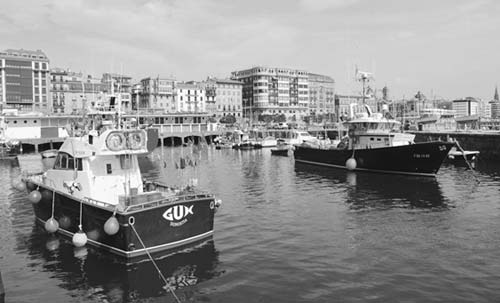
Small boats cruise from the Old Town’s port to the island in the bay (Isla Santa Clara), where you can hike the trails and have lunch at the lone café, or pack a picnic before setting sail. Motoras de la Isla offers two different options: the direct red (roja) route to the island (€3.80 round-trip, small ferry departs May-Sept only, every half-hour, 10:00-20:00) and the blue (azul) route, which cruises the bay for 25 minutes in a glass-bottom boat before dropping passengers off (€6 round-trip, hourly, 11:00-19:30; tel. 943-000-045, www.motorasdelaisla.com). The Ciudad San Sebastián catamaran gives 40-minute tours of the bay from Monte Igueldo to Zurriola Beach (€9, tel. 943-287-932, www.ciudadsansebastian.com).
This museum’s two floors of exhibits describe the seafaring city’s history, revealing the intimate link between the Basque culture and the sea.
Cost and Hours: €1.20, free on Thu, borrow English description at entry, Tue-Sat 10:00-13:30 & 16:00-19:30, Sun 11:00-14:00, closed Mon, Paseo del Muelle 24, tel. 943-430-051.
San Sebastián’s aquarium is surprisingly good. Exhibits are thoughtfully described in English and include a history of the sea, a collection of naval vessels, and models showing various drift-netting techniques. You’ll see a petting tank filled with nervous fish; a huge whale skeleton; a trippy, illuminated, slowly tumbling tank of jellyfish; and a mesmerizing 45-foot-long tunnel that lets you look up into a wet world of floppy rays, menacing sharks, and local fish. The local section ends with a tank of shark fetuses safely incubating away from hungry predators. Local kids see the tropical wing and holler, “Nemo!”
Cost and Hours: €13, €7 for kids under 13; July-Aug daily 10:00-21:00; Easter-June and Sept Mon-Fri 10:00-20:00, Sat-Sun 10:00-21:00; Oct-Easter Mon-Fri 10:00-19:00, Sat-Sun 10:00-20:00; last entry one hour before closing, at the end of Paseo del Muelle, tel. 943-440-099, www.aquariumss.com.
The once-mighty castle (Castillo de la Mota) atop the hill deterred most attackers, allowing the city to prosper in the Middle Ages. The free museum within the castle, featuring San Sebastián history, is mildly interesting. Seek out the crumbling memorial to British soldiers who gave their lives to defend the city from Napoleon. The best views from the hill are not from the statue of Christ, but from the ramparts on the left side (as you face the hill), just above the port’s aquarium. Café El Polvorín, nestled in the park, is a free-spirited place with salads, sandwiches, and good sangria.
A walkway allows you to stroll the mountain’s entire perimeter near sea level. This route is continuous from Hotel Parma to the aquarium, and offers an enjoyable after-dinner wander. You can also walk a bit higher up over the port (along the white railing)—called the paseo de las curas, or “priest’s path,” where the clergy could stroll unburdened by the rabble in the streets below. These paths are technically open only from sunrise to sunset (daily May-Sept 8:00-21:00, Oct-April 8:00-19:00), but you can often access them later.
The shell-shaped Playa de la Concha, the pride of San Sebastián, has one of Europe’s loveliest stretches of sand. Lined with a two-mile-long promenade, it allows even backpackers to feel aristocratic. Although it’s pretty empty off-season, sunbathers pack its shores in summer. But year-round it’s surprisingly devoid of eateries and money-grubbing businesses. There are free showers, and cabinas provide lockers, showers, and shade for a fee. For a century, the lovingly painted wrought-iron balustrade that stretches the length of the promenade has been a symbol of the city; it shows up on everything from jewelry to headboards. It’s shaded by tamarisk trees, with branches carefully pruned into knotty bulbs each winter that burst into leafy shade-giving canopies in the summer—another symbol of the city. Café de la Concha serves reasonably priced, mediocre food, but you can’t beat the location of its terrace overlooking the beach (€15 weekday lunch special, tel. 943-473-600).
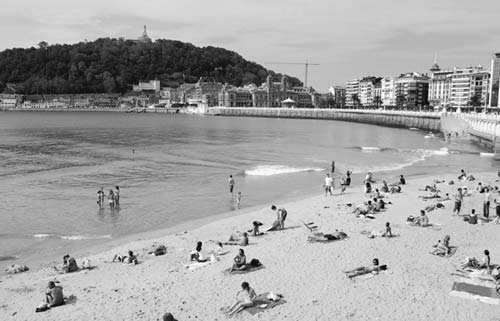
The Miramar palace and park, which divides the crescent beach in the middle, was where Queen María Cristina held court when she summered here. Her royal changing rooms are used today as inviting cafés, restaurants, and a fancy spa. You can walk in the park, although the palace, used as a music school, is closed to the public.
The spa overlooking the beach attracts a less royal crowd today and appeals mostly to visitors interested in sampling “the curative properties of the sea.” You can enjoy its Talasso Fitness Circuit, featuring a hydrotherapy pool, a relaxation pool, a panoramic Jacuzzi, cold-water pools, a seawater steam sauna, a dry sauna, and a relaxation area.
Cost and Hours: €27 for 2-hour fitness circuit, €32 for 3-hour circuit, daily 8:00-22:00, €3 caps and €1 rental towels, bring a swimsuit or buy one for €33, on the beach at the center of the crescent, Paseo de la Concha, tel. 943-458-856, www.la-perla.net.
For commanding city views (if you ignore the tacky amusements on top), ride the funicular up Monte Igueldo, a mirror image of Monte Urgull. The views over San Sebastián, along the coast, and into the distant green mountains are sensational day or night. The entrance to the funicular is on the road behind the tennis club on the far western end of Playa de Ondarreta, which extends from Playa de la Concha to the west.
Cost and Hours: Funicular—€3 round-trip; changeable hours but roughly April-Sept Mon-Tue and Thu-Sun 10:00-22:00, closed Wed; Oct-March Mon-Tue and Thu-Fri 11:00-18:00, Sat-Sun 11:00-20:00, closed Wed. If you drive to the top, you’ll pay €1.90 to enter. Bus #16 takes you from the Old Town to the base of the funicular in about 10 minutes.
Besides the gorgeous view from the top of Monte Igueldo, another classic San Sebastián scene is at this group of three statues by native son Eduardo Chillida (1924-2002). From the base of the Monte Igueldo funicular, walk around the tennis court complex to the edge of the beach. Curly steel prongs “comb the wind” (as the sculptures’ name means) among crashing waves. Chillida lived and died on Monte Igueldo, so these sculptures are now considered a memorial to one of Spain’s most internationally recognized modern sculptors.
The district of Gros, just east across the river from the Old Town, offers a distinct Californian vibe. Literally a dump a few years ago (gross indeed), today it has a surfing scene on Zurriola Beach (popular with students and German tourists) and a futuristic conference center (described next). Long-term plans call for a new promenade that will arc over the water and under Monte Ulía.
These two Lego-like boxes (just east and across the river from the Old Town, in Gros) mark the spot of what was once a grand casino, torn down by Franco to discourage gambling. Many locals wanted to rebuild it as it once was, in a similar style to the turn-of-the-20th-century buildings in the Centro, but—in an effort to keep up with the postmodern trends in Bilbao—city leaders opted instead for Rafael Moneo’s striking contemporary design. The complex is supposed to resemble the angular rocks that make up the town’s breakwater. The Kursaal houses a theater, conference facilities, some gift shops and travel agencies, a restaurant, and the Kubo Gallery. The gallery, located in a small cube furthest from the river, offers temporary exhibits by international artists and promotes contemporary Basque artists. Each exhibit is complemented by a 10-minute video that plays continuously in the gallery theater.
Cost and Hours: Free, Kubo Gallery open Tue-Sun 11:30-13:30 & 17:00-21:00, closed Mon, tel. 943-012-400, www.sala-kubo-aretoa.com.
(€1 = about $1.30, country code: 34)
Rates in San Sebastián fluctuate with the season. When you see a range of prices in these listings, the top end is for summer (roughly July-Sept), and the low end is for the shoulder season (May-June and Oct); outside of these times, you’ll pay even less. Since breakfast is often not included, I’ve recommended some good options elsewhere in town (see “Eating in San Sebastián,” later).
$$$ Hotel Parma is a business-class place with 27 fine rooms and family-run attention to detail and service. It stands stately on the edge of the Old Town, away from the bar-scene noise, and overlooks the river and a surfing beach (Sb-€69-102, windowless interior Db-€101-154, view Db-€122-169, breakfast-€11, air-con, modern lounge, free Wi-Fi, Paseo de Salamanca 10, tel. 943-428-893, www.hotelparma.com, hotelparma@hotelparma.com; Iñaki, Pino, Maria Eugenia, and Eider).
$$ Pensión Edorta (“Edward”), deep in the Old Town, elegantly mixes wood, brick, and color into nine modern, stylish rooms (D-€40-70, Db-€60-90, extra bed-€20-25, slightly more in Aug, elevator, free Wi-Fi, Calle Puerto 15, tel. 943-423-773, www.pensionedorta.com, info@pensionedorta.com, Javier).
$$ Pensión Amaiur is a flowery place with long, narrow halls and 12 great-value rooms within the Old Town. Kind Virginia gives the justifiably popular pensión a homey warmth. Some rooms face a frontón (pelota court), while a couple have private balconies facing the street. Completely renovated in 2013, there are common rooms on each floor to prepare meals—a great spot to hang out and share travel tips. Bring earplugs to block out noise from the tapas-going crowd, or ask for an interior room (S-€40-45, quiet interior D-€60-70, Db-€76-90, T-€76-90, Tb-€90-120, kitchen facilities, pay guest computer, free Wi-Fi, next to Santa María Church at Calle 31 de Agosto 44, tel. 943-429-654, www.pensionamaiur.com, amaiur@telefonica.net).
The pleasant Gros district—San Sebastián’s “uptown”—is marked by the super-modern, blocky Kursaal conference center. The nearby Zurriola Beach is popular with surfers. These hotels are less than a five-minute walk from the Old Town. For locations, see the map on here.
$$$ Hotel Arrizul is bright and fresh, with mod, minimalist decor in each of its 12 rooms (Sb-€55-105, Db-€90-145, Db suite-€110-180, extra bed-€35, breakfast-€7, air-con, elevator, free Wi-Fi, nearby underground parking-€20, Peña y Goñi 1, tel. 943-322-804, www.arrizul.com, info@arrizulhotel.com). Its sister hotel, Hotel Arrizul Gros, is only five blocks away and has 17 rooms with similar decor (slightly lower rates, includes small breakfast) plus 15 spacious apartment rentals (apartments: 2 people-€145-199, 4 people-€185-249, 5 people-€215-279; Iparraguirre 3, same contact info as main Hotel Arrizul).
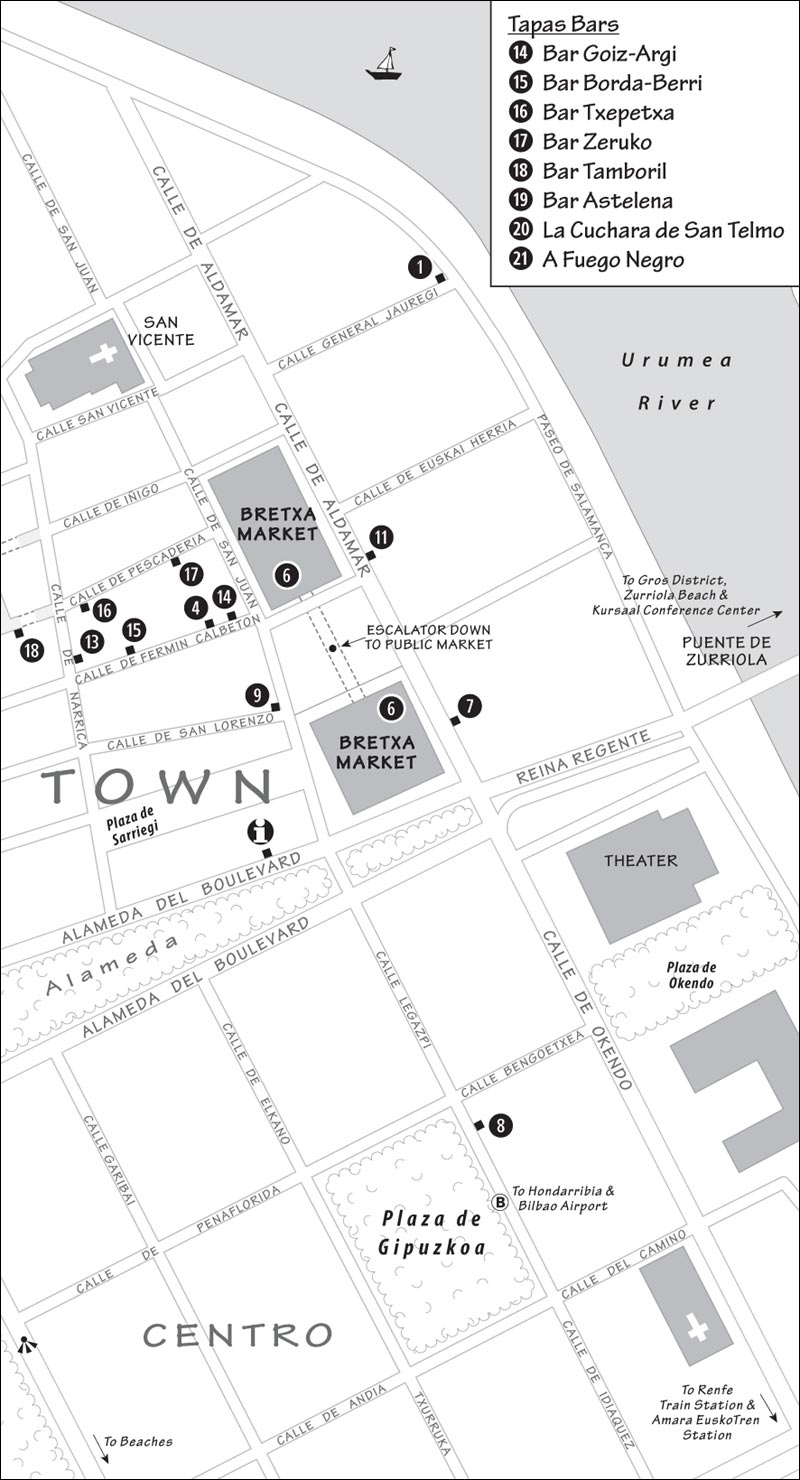
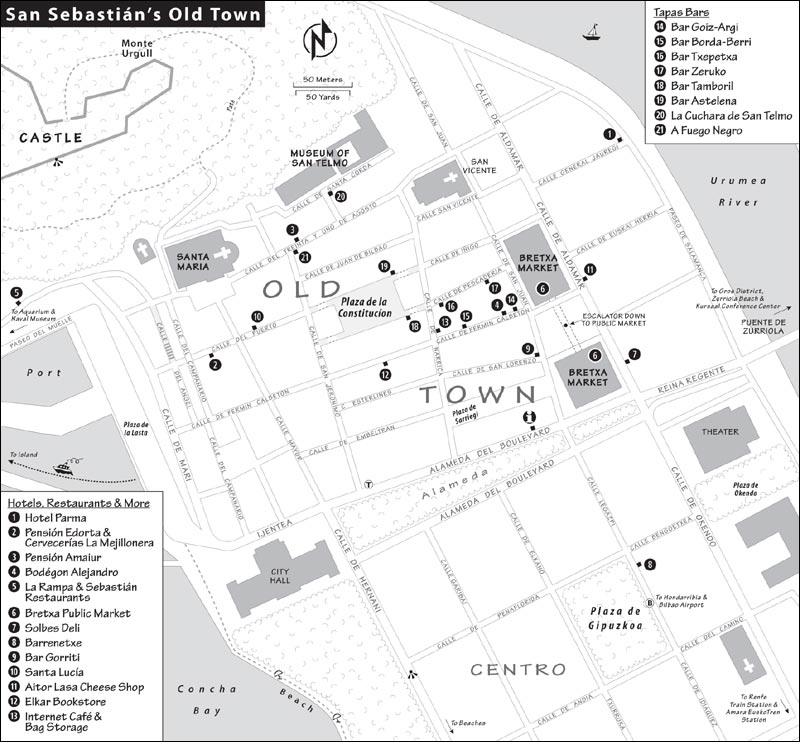
$$ Pensión Kursaal has 21 basic but colorful and modern rooms in a historic building with white and beige decor (Db-€50-91, family room-€84-141, elevator, pay guest computer, free Wi-Fi, parking-€12, Peña y Goñi 2, tel. 943-292-666, www.pensionesconencanto.com, kursaal@pensionesconencanto.com).
$$$ Hotel Niza, set in the middle of Playa de la Concha, is often booked well in advance. Half of its 40 rooms (some with balconies) overlook the bay. From its chandeliered and plush lounge, a classic elevator takes you to comfortable pastel rooms with wedding-cake molding (tiny interior Sb-€55-68, Db-€132-157, view rooms cost the same—request one when you reserve...but no promises, extra bed-€22, only streetside rooms have air-con, fans on request, great buffet breakfast-€11, free guest computer and Wi-Fi, parking-€15/day—must reserve in advance, Zubieta 56, see map on here for location, tel. 943-426-663, www.hotelniza.com, niza@hotelniza.com). The breakfast room has a sea view and doubles as a bar with light snacks throughout the day (Bar Narru, daily 7:30-24:00).
Basque food is regarded as some of the best in Spain, and San Sebastián is the culinary capital of the Basque Country. What the city lacks in museums and sights, it more than makes up for in food. (For tips on Basque cuisine, see here.) San Sebastián is proud of its many Michelin-rated fine-dining establishments, but they require a big commitment of time and money. Most casual visitors will prefer to hop from pub to pub through the Old Town, following the crowds between Basque-font signs. I’ve listed a couple of solid traditional restaurants, but for the best value and memories, I’d order top-end dishes with top-end wine in top-end bars. Some places close for siesta in the late afternoon and early evening.
(See “San Sebastián’s Old Town” map, here.)
San Sebastián’s Old Town provides the ideal backdrop for tapas-hopping; just wander the streets and sidle up to the bar in the liveliest spot. Calle Fermín Calbetón has the best concentration of bars; the streets San Jerónimo and 31 de Agosto are also good. I’ve listed these top-notch places in order as you progress deeper into the Old Town—though you have to backtrack after Bar Zeruko. Note that there are plenty of other options along the way. Before you begin, study the sidebar on the next page.
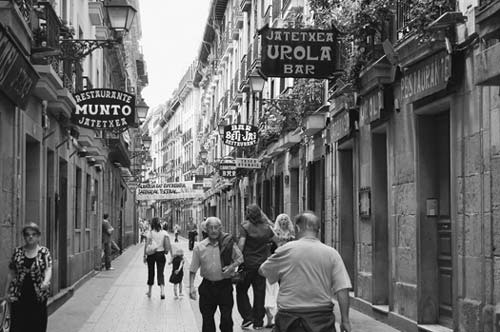
Bar Goiz-Argi (“Morning Light”), every local’s top recommendation, serves its tiny dishes with pride and attitude. Advertising pintxos calientes, they cook each treat for you, allowing you a montage of petite gourmet snacks. Try their tartaleta de txangurro (spider-crab spread on bread), spicy morcilla (blood sausage made with rice), or their signature brocheta de gambas (shrimp kebab). A good selection of open wine bottles are clearly priced and displayed on the shelf (great prices, no chairs, congregate at bar, open daily, Calle Fermín Calbetón 4, tel. 943-425-204).
Bar Borda-Berri (loosely, “Mountain Hut”), a couple doors down, features a more low-key ambience and top-quality €3 pintxos. There are only a few items at the bar; check out the chalkboard menu for today’s options, order, and they’ll cook it fresh. The specialty here is melt-in-your-mouth beef cheeks (carrillera de tenera) in a red-wine sauce, risotto with wild mushrooms, and foie gras (grilled goose liver) with apple jelly, which is even better paired with a glass of their best red wine (closed Mon, Calle Fermín Calbetón 12, tel. 943-430-342).
Bar Txepetxa is the place for anchovies. A plastic circle displaying a variety of antxoas tapas makes choosing your anchovy treat easy. These fish are fresh—not cured and salted like those most Americans hate (€2.50/pintxo, Tue lunch only, closed Sun-Mon, Calle Pescadería 5, tel. 943-422-227).
Bar Zeruko offers fun for molecular gastronomy fans in a bright, modern setting. The selections are seasonal, but look for hoguera, a piece of cod served over a smoking mini-hearth with a side of “liquid” salad. Award-winning chef Joxean Calvo continually surprises his patrons (€5 pintxos, Tue-Sat 11:00-16:00 & 19:00-24:00, Sun 19:00-24:00, closed Mon, Calle Pescadería 10, tel. 943-423-451, www.barzeruko.com).
Bar Tamboril is a traditional spot right on the main square favored for its seafood, mushrooms (txampis tamboril), and anchovy tempura along with its good prices. Their list of hot pintxos (grab the little English menu on the bar) makes you want to break the one-tapa-per-stop rule (Calle Pescadería 2, tel. 943-423-507).
Bar Astelena, across the square from Tamboril, serves a delicious blend of traditional and modern plates, all thoughtfully presented. Try any of the specials, particularly the solomillo a lo pobre (small sirloin fillet with mini-fries and a fried egg). Other standouts include rabo de buey (oxtail) and capellini-wrapped prawns. There’s no English menu, but the staff is happy to help translate (€3-4 pintxos, Calle de Iñigo 1, tel. 943-425-245).
La Cuchara de San Telmo, with cooks taught by a big-name Basque chef, Alex Mondiel, is a cramped place that devotes as much space to its thriving kitchen as its bar. It has nothing precooked and set on the bar—order your mini-gourmet plates with a spirit of adventure from the constantly changing blackboard. Their foie gras with apple jelly is rightfully famous (€3 pintxos, closed Mon, tucked away on a lonely alley called Santa Corda behind Museum of San Telmo at 31 de Agosto #28, tel. 943-435-446).
A Fuego Negro is cool and upscale compared with the others, with a hip, slicker vibe and a blackboard menu of pintxos and drinks (there’s an English translation sheet). They have a knack for mixing gourmet pretentiousness with whimsy here: Try their arroz, tomate, y un huevo (risotto with tomato and egg); bakailu (cod); and regaliz (licorice ice cream) trio for a unique taste-bud experience (€3.60). Enjoy their serious and extensive wine selection (closed Mon, 31 de Agosto #31, tel. 650-135-373). An inviting little section in the back makes this a sit-down dining opportunity.
Cervecerías La Mejillonera is famous among students for its big, cheap beers, patatas bravas, and mussels (“tigres” is the spicy favorite). A long, skinny stainless-steel bar and lots of photos make ordering easy—this is the only place in town where you pay when served. Throw your mussels shells on the floor like the locals (Calle Puerto 15, tel. 943-428-465).
Bodégon Alejandro is a good spot for modern Basque cuisine in a traditional cellar setting (three-course fixed-price lunch-€20, Tue-Sun 13:00-15:30 & 20:30-22:30 except closed Sun night, closed Mon, in Old Town on Calle Fermín Calbetón 4, tel. 943-427-158).
Seafood Along the Port: For seafood with a salty sailor’s view, check out the half-dozen hardworking, local-feeling restaurants that line the harbor on the way to the aquarium. La Rampa is an upscale eatery, specializing in crab (txangurro) and lobster dishes and seafood parillada (€30-50 for dinner, closed Tue evenings, also closed Wed and Sun in winter, Paseo Muelle/Kaiko Pasealekua 26-27, tel. 943-421-652, www.restaurantelarampa.com). Also along here, locals like Sebastián (more traditional, closed Tue).
A picnic on the beach or atop Monte Urgull is a tempting option. You can assemble a bang-up spread at the Bretxa Public Market at Plaza de Sarriegi (described earlier).
Solbes, just across the street from the Bretxa Public Market, has a reputation as the gourmet deli store in the Old Town. There’s a remarkable wine selection in the back cellar, plus high-quality cured meats and cheeses out front. Be sure to price fruits and veggies yourself on the scale to avoid confusion at checkout (Mon-Sat 9:00-20:30, closed Sun, Calle Aldamar 4, tel. 943-427-818).
Upscale Barrenetxe has an amazing array of breads, prepared foods, and some of the best desserts in town. In business since 1699, their somewhat formal service is justified. There’s also coffee served in a new bar section (daily 8:00-20:00, Plaza de Guipúzcoa 9, tel. 943-424-482).
If your hotel doesn’t provide breakfast—or even if it does—consider one of these places. The first is a traditional stand-up bar; the second is a greasy spoon.
Bar Gorriti, delightfully local, is packed with market workers and shoppers starting their day. You’ll stand at the bar and choose a hot-off-the-grill francesca jamón omelet (fluffy mini-omelet sandwich topped with a slice of ham) and other goodies (€2 each). This and a good cup of coffee makes for a very Basque breakfast. By the time you get there for breakfast, many market workers will be taking their mid-morning break (daily, breakfast served 7:00-10:00, facing the side of the big white market building at San Juan 3, tel. 943-428-353).
Santa Lucía, a 1950s-style diner, is ideal for a cheap Old Town breakfast or churros break (churros are like deep-fried doughnut sticks that can be dipped in pudding-like hot chocolate). Photos of two dozen different breakfasts decorate the walls, and plates of fresh churros keep patrons happy. Grease is liberally applied to the grill...from a squeeze bottle (daily 8:30-21:30, Calle Puerto 6, tel. 943-425-019).
San Sebastián has two train stations: Amara EuskoTren and RENFE (described under “Arrival in San Sebastián” on here). The station you use depends on your destination.
Amara EuskoTren Station: If you’re going into France, take the regional Topo train (which leaves from the Amara EuskoTren Station) over the French border into Hendaye (usually 4/hour Mon-Fri, 2/hour Sat-Sun, 35 minutes). From Hendaye, connect to France’s SNCF network (www.sncf.com), where connections include Paris (6/day direct, 5.5-6 hours; 12-hour night train, weekends only off-season, reservations required). Unfortunately, San Sebastián’s EuskoTren Station doesn’t have information on Paris-bound trains from Hendaye. EuskoTren tickets to Hendaye must be used within two hours of purchase (or else they expire).
Also leaving from San Sebastián’s Amara EuskoTren Station are slow regional trains to destinations in Spain’s Basque region, including Bilbao (hourly, 2.5 hours—the bus is faster, EuskoTren info: tel. 902-543-210, www.euskotren.es). Although the train ride from San Sebastián to Bilbao takes twice as long as the bus, it passes through more interesting countryside. The Basque Country shows off its trademark green and gray: lush green vegetation and gray clouds. It’s an odd mix of heavy industrial factories, small homegrown veggie gardens, streams, and every kind of livestock you can imagine.
RENFE Station: This station handles long-distance destinations within Spain (most of which require reservations). Connections include Irún (8/day, 25 minutes), Hendaye, France (4/day, 30 minutes; better connections on EuskoTren, described above), Madrid (4/day, 5.25-7.25 hours), Burgos (6/day, 3 hours), León (2/day, 5 hours), Pamplona (2/day, 1.75 hours), Salamanca (5/day, 6 hours), Barcelona (2/day, 6 hours), and Santiago de Compostela (1/day direct, 10.5 hours).
San Sebastián’s “bus station,” called Amara (for the neighborhood), is a congregation of bus parking spots next to the big Hotel Amara Plaza, at the Plaza Pío XII (on the river, four blocks south of EuskoTren Station; take bus #21, #26, or #28 from Boulevard). Some schedules are posted at various stops, but confirm departure times. You must buy your tickets in advance at the bus companies, with offices on either side of the block north of the station area (toward downtown, along Avenida de Sancho el Sabio and Paseo de Vízcaya). Bus tickets are not available from the driver. The Pesa office, which serves St-Jean-de-Luz and Bilbao, is located at Avenida de Sancho el Sabio 33 (tel. 902-101-210, www.pesa.net). The Alsa office—which serves Madrid, Burgos, and León—is just beyond Pesa at Sancho el Sabio 31 (tel. 902-422-242, www.alsa.es). Conda—which serves Pamplona and Bayonne—shares an office with Alsa (tel. 943-461-064, www.conda.es). The Vibasa office—which serves Burgos, Pamplona, and Barcelona—is on the other side of the block along the river, at Calle Vizcaya 15 (closed 13:30-15:00, tel. 902-101-363, www.vibasa.com).
From San Sebastián, buses go to Bilbao (2/hour, hourly on weekends, 6:30-22:00, 1.25 hours, get ticket from Pesa office, departs from Amara; morning buses fill with tourists, commuters, and students, so consider buying your ticket the day before; once in Bilbao, buses leave you at Termibús stop with easy tram connections to the Guggenheim modern-art museum); Bilbao Airport (a Pesa bus leaves directly from Plaza Pío XII, hourly, 1.25 hours, get tickets from Pesa office), Pamplona (8-10/day, 1 hour, Conda office), León (1/day, 6 hours, Alsa office), Madrid (8/day, 6 hours direct, otherwise 7 hours; a few departures direct to Madrid’s Barajas Airport, 5.25 hours; Alsa office), Burgos (7/day, 2-3.25 hours, Alsa or Vibasa office), and Barcelona (2/day and 1 at night, 7 hours, Vibasa office).
To visit Hondarribia (described next), you can catch bus #E21 or #E23 much closer to the center at Plaza de Gipuzkoa (1 block south of TI; about 3/hour, 35 minutes, #E21 goes to airport en route to Hondarribia).
Buses to French Basque Country: A bus goes from San Sebastián’s Amara bus station to St-Jean-de-Luz (Mon-Sat only, 2/day at 9:00 and 14:30, none on Sun, 1 hour, return trips at 12:45 and 19:15, only 1/week off-season, get ticket from Pesa office), then continues directly to Biarritz (1.25 hours from San Sebastián) and Bayonne (1.5 hours from San Sebastián).
For a taste of small-town País Vasco, dip into this enchanting, seldom-visited town. It’s more commonly known by its Euskara name, Hondarribia, than the Spanish version, Fuenterrabía. Much smaller and easier to manage than San Sebastián, and also closer to France (across the picturesque Bay of Txingudi from Hendaye), Hondarribia allows travelers a stress-free opportunity to enjoy Basque culture. While it’s easy to think of this as a border town (between France and Spain), culturally it’s in the middle of the Basque Country.
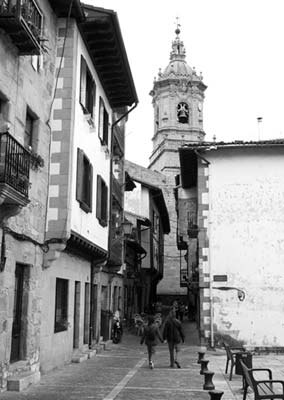
The town comes in two parts: the lower port town and the historic, balcony-lined streets of the hilly and walled upper town. The upper town, which feels quite manicured, is a delightful place to poke around if you have time. The main square is fronted by Charles V’s austere, oddly squat castle (now a parador inn—see next page). You can follow the TI’s self-guided tour of the Old Town (English brochure available) or just lose yourself within the walls to discover hidden plazas and former royal residences. In the modern lower town, straight shopping streets serve a local clientele, and a pleasant walkway takes strollers along the beach.
Tourist Information: There are two TIs. One is located on the main square, Plaza de Armas, across from the parador; the other is at Minatera 9, near the port (both July-Sept daily 10:30-13:30 & 15:30-20:00; Oct-June Tue-Sat 10:00-13:30 & 15:30-18:30, Sun 10:00-14:00, closed Mon; tel. 943-645-458, www.bidasoaturismo.com).
Arrival in Hondarribia: For some beach time, drivers can use the metered parking by the port (marked with blue lines, prepay for parking at machine). If you’re here during the week off-season, the giant lot on the beach is free. Drivers who only want to explore the Old Town should follow signs to Casco Viejo and park at the free, tree-lined lot immediately across from the gate in the city wall; look for its giant coat-of-arms (Alameda de Daniel Vázquez Díaz). Buses into town stop near the main square.
Sleeping in Hondarribia: Accommodations are pricey here, but it’s a nice small-town alternative to San Sebastián. $$$ Parador El Emperador, with 34 rooms housed in a former imperial fortress, is the town’s splurge. Tourists are allowed to have sangria in the muy cool bar, though the terraces are for guests only (Sb-€188, Db-€248, Db with view-€270, includes breakfast, elevator, free Wi-Fi, Plaza de Armas 14, tel. 943-645-500, www.parador.es, hondarribia@parador.es). $$ Hotel San Nikolas, facing the parador from across the square, offers a more affordable alternative, with 17 nicely appointed rooms (many with views) above a local café (Sb-€41-61, Db-€66-83, Db with sea view-€83-99, higher price is for mid-July-mid-Sept, can be even cheaper Mon-Thu off-season, elevator, free Wi-Fi, Plaza de Armas 6, tel. 943-644-278, www.hotelsannikolas.es, info@hotelsannikolas.es).
Hondarribia Connections: From Hondarribia, buses go to San Sebastián’s Plaza de Gipuzkoa (about 3/hour, 35 minutes on express buses #E23 or #E21, departs near main square—#E21 also stops at airport; or twice as long on local public buses #E26 and night bus #E77) and to Irún near the French border (2/hour, 20 minutes, buses #E25 and night bus #E77). A boat goes to Hendaye (4/hour in summer, 2/hour off-season, 10 minutes, runs about 11:00-19:00 or until dark).
Route Tips for Drivers: Leaving San Sebastián passing Zurriola Beach in Gros, first follow signs to Irún/Frantzia; signs for Hondarribia appear after about 20 minutes. If continuing on to St-Jean-de-Luz, signs to Baiona lead back to the main highway and the French border. Have coins ready to chuck into the automatic tollbooth.
Between the two Spanish Basque cities of San Sebastián and Bilbao is a beautiful countryside of rolling green hills and a scenic, jagged coastline that looks almost Celtic. Aside from a scenic joyride, this area merits a visit for the cute fishing and resort town of Lekeitio.
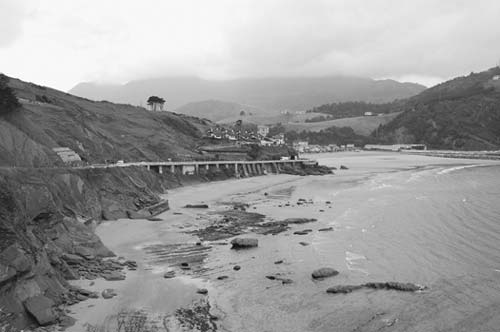
San Sebastián and Bilbao are connected in about an hour and a quarter by the A-8 expressway (€9.50 toll). While speedy and scenic, this route is nothing compared to some of the free, but slower, back roads with lots of twists and turns that connect the two towns.
If side-tripping from San Sebastián to Bilbao, you can drive directly there on A-8 in the morning. But coming home to San Sebastián, consider this more scenic route: Take A-8 until the turnoff for Guernica (look for Amorebieta/Gernika-Lumo sign), then head up into the hills on BI-635. After visiting Guernica, follow signs along the very twisty BI-2238 road to Lekeitio (about 40 minutes). Leave Lekeitio on the road just above the beach; after crossing the bridge, take the left fork and follow BI-3438 to Markina/Ondarroa (with a striking modern bridge and nice views back into the steep town; follow portua signs for free 30-minute parking at the port). Continue to Mutriku and Deba as you hug the coastline east toward San Sebastián. There’s a good photo-op pullout as you climb along the coast just after Deba. Soon after, you’ll have two opportunities to get on the A-8 (blue signs) for a quicker approach to San Sebastián; but if you’ve enjoyed the scenery so far, stick with the coastal road (white signs, N-634) through Zumaia and Getaria, rejoining the expressway at the high-class resort town of Zarautz.
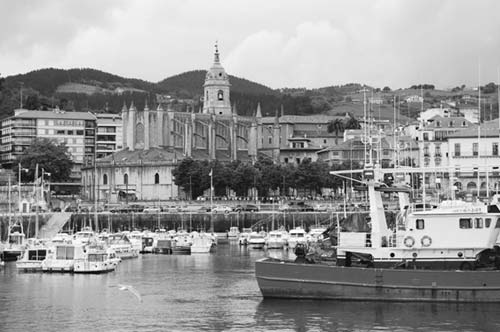
More commonly known by its Euskara name, Lekeitio (leh-KAY-tee-oh)—rather than the Spanish version, Lequeitio—this small fishing port has an idyllic harbor and a fine beach. It’s just over an hour by bus from Bilbao and an easy stop for drivers, and is protected from the Bay of Biscay by a sand spit that leads to the lush and rugged little San Nicolás Island. Hake boats fly their Basque flags, and proud Basque locals black out the Spanish translations on street signs.
Lekeitio is a teeming resort during July and August (when its population of 7,000 triples as big-city Basque folks move into their vacation condos). Isolated from the modern rat race by its location down a long, windy little road, it’s a backwater fishing village the rest of the year.
Sights here are humble, though the 15th-century St. Mary’s Parish Church is a good example of Basque Gothic, with an impressive altarpiece (Mon-Sat 8:00-12:00 & 17:00-19:30, Sun 9:00-12:30). The town’s back lanes are reminiscent of old days when fishing was the only industry. Fisherwomen sell their husbands’ catches each morning from about 10:30 along the port. The golden crescent beach is as inviting as the sandbar, which—at low tide—challenges you to join the seagulls out on San Nicolás Island.
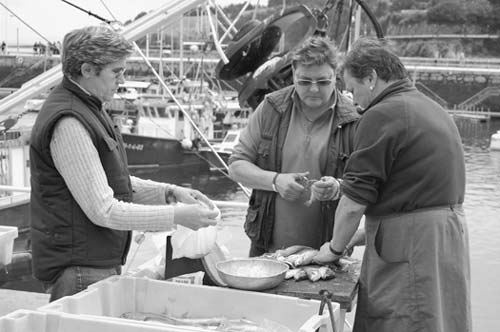
The best beach in the area for surfers and sun-lovers is Playas Laga (follow signs off the road from Bilbao to Lekeitio). Relatively uncrowded, it’s popular with body-boarders.
Getting There: Buses connect Lekeitio with Bilbao (hourly, 1.25 hours; same bus stops at Guernica, 40 minutes) and San Sebastián (4/day Mon-Fri, 2/day Sat-Sun, 1.25 hours). But this destination is most logical for those with a car. Drivers can park most easily in the lot near the bus station. Exit the station left, walk along the road, then take the first right (down the steep, cobbled street) to reach the harbor. There is no luggage storage in town.
Tourist Information: The TI faces the fish market next to the harbor (July-Aug daily 10:00-14:00 & 16:00-20:00; Sept-June Tue-Sat 10:30-13:30 & 16:00-19:00, Sun 10:00-14:00, closed Mon; tel. 946-844-017, www.lekeitio.com).
Sleeping in Lekeitio: $$ Emperatriz Zita Hotel is the obvious best bet for your beach-town break. It’s named for Empress Zita (who lived here in exile after her Habsburg family lost World War I and was booted from Vienna). Zita’s mansion burned down, but this 1930s rebuild still has a belle époque aristocratic charm, solid classy furniture in 42 spacious rooms, real hardwood floors, and an elegant spa in the basement. Located on the beach a few steps from the harbor, with handy free parking and a view restaurant, it’s a fine value (Sb-€60-77, Db-€70-101, Db suite-€103-134, views—ask for vistas del mar—are worth it, prices can be higher July-Aug and Sat all year, extra bed-€25, breakfast-€10, elevator, free Wi-Fi, Santa Elena Etorbidea, tel. 946-842-655, www.aisiahoteles.com, lekeitio@aisiahoteles.com). The hotel also has a thermal seawater pool, a Jacuzzi, and a full-service spa (all available at reasonable prices).
Eating in Lekeitio: Although it’s sleepy off-season, the harbor promenade is made-to-order in summer for a slow meal or a tapas crawl. Restaurante Kaia offers a mostly seafood menu, with a €15 fixed-priced lunch (Tue-Sat lunch and dinner, Sun dinner only, closed Mon, on the harbor at Txatxo Kaia 5, tel. 946-840-284).
The workaday market town of Guernica (GEHR-nee-kah) is near and dear to Basques and pacifists alike. This is the site of the Gernikako Arbola—the oak tree of Gernika, which marked the assembly point where the regional Basque leaders, the Lords of Bizkaia, met through the ages to assert their people’s freedom. Long the symbolic heart of Basque separatism, it was also a natural target for Franco (and Hitler) in the Spanish Civil War—resulting in an infamous bombing raid that left the town in ruins (see “The Bombing of Guernica” sidebar), as immortalized by Picasso in his epic work Guernica.
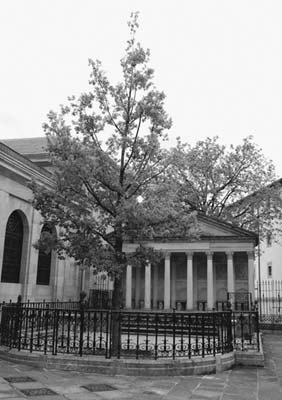
Today’s Guernica, rebuilt after being bombed flat in 1937 and nothing special at first glance, holds some of the Basque Country’s more compelling museums. And Basque bigwigs have reclaimed the town as a meeting point—they still elect their figurehead leader on that same ancient site under the oak tree.
Guernica is small (about 17,000 inhabitants) and compact, focused on its large market hall (Monday market 9:00-14:00).
Tourist Information: The TI is in the town center (daily 10:00-14:00 & 16:00-18:00, longer hours in summer, Artekalea 8, tel. 946-255-892, www.gernika-lumo.net). Pick up the free, good town map. If you’ll be visiting both the Peace Museum and the Basque Country Museum, buy the €6 combo-ticket here.
Arrival in Guernica: Drivers will find a handy parking lot near the train tracks at the end of town. Buses drop off passengers along the main road skirting the town center. No matter where you enter, the TI is well-signed (look for yellow i signs)—head there first to get your bearings.
I’ve arranged Guernica’s sights in the order of a handy sightseeing loop from the TI.
• Exit the TI to the left, cross the street, and walk up the left side of the square, where you’ll find the...
Because of the brutality of the Guernica bombing, and the powerful Picasso painting that documented the atrocities of war, the name “Guernica” has become synonymous with pacifism. This thoughtfully presented exhibit has taken a great tragedy of 20th-century history and turned it into a compelling cry for peace in our time. Borrow the English translations at the entry, request an English showing of the movie upstairs, and head up through the two-floor exhibit. The first floor begins by considering different ways of defining “peace.” You’ll then enter an apartment and hear a local woman, Begoña, describe her typical Guernica life in the 1930s...until the bombs dropped (a mirror effect shows you the devastating aftermath). You’ll exit through the rubble into an exhibit about the town’s history, with a special emphasis on the bombing. Finally, a 10-minute movie shows grainy footage of the destruction, and ends with a collage of peaceful reconciliations in recent history—in Ireland, South Africa, Guatemala, Australia, and Berlin. On the second floor, Picasso’s famous painting is superimposed on three transparent panels to highlight different themes. The exhibit concludes with a survey of the recent history of conflicts in the Basque Country.
Cost and Hours: €5; Tue-Sat 10:00-19:00, Sun 10:00-14:00, closed Mon; Foru Plaza 1, tel. 946-270-213, www.peacemuseumguernica.org.
• Continue uphill to the big church. At the road above the church, you can turn right and walk a block and a half to find an underwhelming tile replica of Picasso’s Guernica (left-hand side of the street). Or you can head left to find the next two attractions.
This well-presented exhibit offers a good overview of Basque culture and history. Start in the ground-floor theater (Room 4) and see the overview video (request English). Follow the suggested route and climb chronologically up through Basque history, with the necessary help of an included audioguide. You’ll find exhibits about traditional Basque architecture and landscape, lots of antique maps, and a region-by-region rundown of the Basque Country’s seven territories. One interesting map shows Basque emigration over the centuries—including to the US. The top floor is the most engaging, highlighting Basque culture: sports, dances, cuisine, myths and legends, music, and language, plus a wraparound movie featuring images of a proud people living the Basque lifestyle.
Cost and Hours: €3, free on Sat, includes audioguide—except on Sat, open Tue-Sat 10:00-14:00 & 16:00-19:00, Sun 10:30-14:30, closed Mon, Allendesalazar 5, tel. 946-255-451.
In the Middle Ages, the meeting point for the Basque general assembly was under the old oak tree on the gentle hillside above Guernica. The tradition continues today, as the tree stands at the center of a modest but interesting complex celebrating Basque culture and self-government.
Cost and Hours: Free, daily 10:00-14:00 & 16:00-18:00, June-Sept until 19:00, on Allendesalazar, tel. 946-251-138.
 Self-Guided Tour: As you enter the grounds past the guard hut, on the right you’ll see an old tree trunk in the small colonnade dating from the 1700s. Basque traditions have lived much, much longer than a single tree’s life span. When one dies, it’s replaced with a new one. This is the oldest surviving trunk.
Self-Guided Tour: As you enter the grounds past the guard hut, on the right you’ll see an old tree trunk in the small colonnade dating from the 1700s. Basque traditions have lived much, much longer than a single tree’s life span. When one dies, it’s replaced with a new one. This is the oldest surviving trunk.
The exhibit has four parts: a stained-glass window room, the oak-tree courtyard, the assembly chamber, and a basement theater (request the 10-minute video in English that extols the virtues and beauties of the Basque Country).
Inside the main building, request a copy of the English-language brochure that describes in detail the importance of this site. First find the impressive stained-glass window room. The computer video here gives a good six-minute overview of the exhibit (plays in English when you click). The gorgeous stained-glass ceiling is rife with Basque symbolism. The elderly leader stands under the oak holding a book with the “Old Law” (Lege Zarra), which are the laws by which the Basques lived for centuries. Below him are groups representing the three traditional career groups of this industrious people: sailors and fishermen; miners and steelworkers; and farmers. Behind them all is a classic Basque landscape: On the left is the sea, and on the right are rolling green hills dotted with red-and-white homes. Small, square panels around the large window represent all the important towns in the region, with Guernica’s oak tree easy to pinpoint.
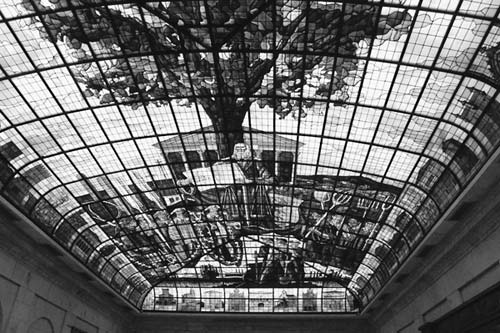
Out back, a Greek-style tribune surrounds the fateful oak tree. This little fella is from 2005, planted when the earlier one “finished out its life cycle” after standing here for nearly a century and a half. This tree is a descendant of that one, and possibly of all the trees here since ancient times. This location is where Basque leaders have met in solidarity across the centuries.
In the Middle Ages, after Basque lands became part of Castile, Castilian kings came here to pledge respect to the old Basque laws. When Basque independence came under fire in the 19th century, patriots rallied by singing a song about this tree (“Ancient and holy symbol / Let thy fruit fall worldwide / While we gaze in adoration / Upon thee, our blessed tree”). After the 1937 bombing, in which this tree’s predecessor was miraculously unscathed, hundreds of survivors sought refuge under its branches. Today, although official representatives in the Spanish government are elected at the polls, the Basques choose their figurehead leader, the Lehendakari (“First One”), in this same spot.
Step back inside and enter the assembly chamber—like a mini-parliament for the region of Bizkaia (“Vízcaya” in Spanish, “Biscay” in English; one of the seven Basque territories). Notice the holy water and the altar—a sign that there’s no separation of church and state in Basque politics. The large paintings above the doors show the swearing of allegiance to the Old Law. Portraits of 26 former Lords of Bizkaia maintain a watchful eye over the current assembly’s decisions.
Guernica is well-connected to Bilbao (2 trains/hour, 50 minutes, arrive at Bilbao’s Atxuri Station; also 4 buses/hour, 40 minutes) and to Lekeitio (hourly buses, 40 minutes). Connections are sparser on weekends. The easiest way to connect to San Sebastián is via Bilbao, though you can also get there on the slow “Topo” EuskoTren train (transfer in Lemoa, about 3-4 hours).
In recent years, Bilbao (bil-BOW, rhymes with “cow”) has seen a transformation like no other Spanish city. Entire sectors of the industrial city’s long-depressed port have been cleared away to allow construction of a new convention center and the stunning Guggenheim Museum.
Bilbao retains less and less of its grim industrial past...and looks toward an exciting new future. But some of the grime hangs on. The city mingles beautiful but crumbling old buildings; eyesore high-rise apartment blocks; brand-new super-modern additions to the skyline (such as the Guggenheim and its neighbor, the 40-story Iberdrola Tower); and, scattered in the lush green hillsides all around the horizon, typical whitewashed Basque homes with red roofs. Bilbao enjoys a vitality and well-worn charm befitting its status as a regional capital of culture and industry.
For most visitors, the Guggenheim is the main draw (and many could spend the entire day there). But with a little more time, it’s also worth hopping on a tram to explore the atmospheric Old Town (Casco Viejo). With extra time, take the Mount Artxanda funicular for a breathtaking overview of the entire area. Don’t bother coming to Bilbao on Monday, when virtually all its museums—including the almighty Guggenheim—are closed (except in July-Aug).
When you’re in the center, Bilbao feels smaller than its population of 350,000. The city, nestled amidst green hillsides, hugs the Bilbao River as it curves through town. The Guggenheim is more or less centrally located near the top of that curve; the bus station is to the west; the Old Town (Casco Viejo) and train stations are to the east; and a super-convenient and fun-to-ride green tram called the EuskoTran ties it all together.
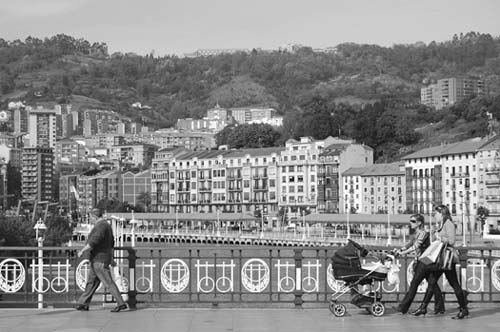
Bilbao’s handiest TI is next to the Guggenheim (look for the i sign on top of a pole). Pick up a city map and the bimonthly Bilbao Guide. If you’re interested in something beyond the Guggenheim, ask about walking tours in English (€4.50, Sat-Sun year-round, more often in summer) and grab the Bilbao museums brochure, describing museums dedicated to everything from bullfighting and seafaring to sports and Holy Week processionals (July-Aug daily 10:00-19:00; Sept-June Mon-Fri 10:00-19:00, Sat 11:00-19:00, Sun 11:00-15:00; tel. 944-795-760, www.bilbao.net). Convenient TI branches are open at the airport (daily), at the Plaza del Ensanche near the Zubizuri Bridge (Mon-Fri only), and at Arriaga Theater at Plaza de Arriaga, near the Old Town (daily, but the Arriaga TI will likely close sometime in 2014).
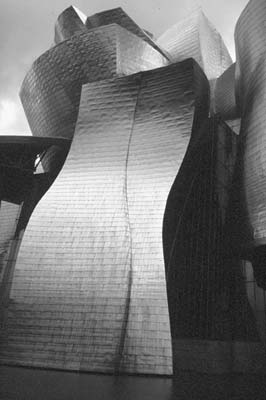
Most travelers—whether arriving by train, bus, or car—will want to go straight to the Guggenheim. Thanks to a perfectly planned tram system (EuskoTran), this couldn’t be easier. From any point of entry, simply buy a €1.40 single-ride ticket at a user-friendly green machine (€3.85 for an all-day pass), hop on a green-and-gray tram, enjoy the Muzak, and head for the Guggenheim stop (there’s only one line, trams come every 10-15 minutes, tel. 902-543-210, www.euskotren.es—choose “Tranvía Bilbao”). When you buy your ticket, validate it immediately at the machine (follow the red arrow), since you can’t do it once on board. If you get lost, ask: “¿Dónde está el Guggenheim?” (DOHN-day ay-STAH el “Guggenheim”). Note that the only luggage storage in town is at the Termibús Station (not at either train station). Don’t confuse the green tram (EuskoTran) with the slow, scenic, blue train to San Sebastián (EuskoTren).
By Train: Bilbao’s RENFE station (serving most of Spain) is on the river in central Bilbao. The train station is on top of a small shopping mall (a Europcar rental office is near the train-station ticket office, tel. 944-239-390). To reach the tram to the Guggenheim, descend into the stores. Leave from the exit marked Hurtado de Amézaga, and go right to find the BBK bank. Enter, find the Automatikoa door on the right, and buy your ticket at the green machine marked Abando (the machine is mixed in with a bunch of ATMs). Leave the bank and continue right around the corner. Validate your ticket at the machines at the tram stop before boarding the tram (direction: La Casilla).
Trains coming from San Sebastián arrive at the riverside Atxuri Station, southeast of the museum. From here the tram (direction: La Casilla) follows the river to the Guggenheim stop.
By Bus: Buses stop at the Termibús Station on the western edge of downtown, about a mile southwest of the Guggenheim. Don’t expect a real building—it’s just a covered parking lot with small portables. The tram (San Mamés Station) is on the road just below the station—look for the steel CTB sign or follow the Tran signs. Buy and validate a ticket at the machine, and hop on the tram (direction: Atxuri) to the Guggenheim or Old Town.
By Plane: Bilbao’s compact, modern, user-friendly airport (airport code: BIO) is about six miles north of downtown. Everything branches off the light-and-air-filled main hall, designed by prominent architect Santiago Calatrava. A handy bus (#3247) takes you directly to the center (€1.35, pay driver, 2/hour, 20-minute trip, makes three stops downtown—the first one is closest to the Guggenheim—before ending at the Termibús Station). To find the bus, turn right out of the terminal. A taxi into town costs about €25. To get to San Sebastián, you can take a direct bus from Bilbao Airport (€16.50, pay driver, runs hourly, 1.25 hours, drops off at Plaza Pío XII in San Sebastián, www.pesa.net). A taxi directly to San Sebastián will run you €150.
By Car: A big underground parking garage is near the museum; if you have a car, park it here and use the tram. From the freeway, take the exit marked Centro (with bull’s-eye symbol), follow signs to Guggenheim (you’ll see the museum), and look for the big P that marks the garage.
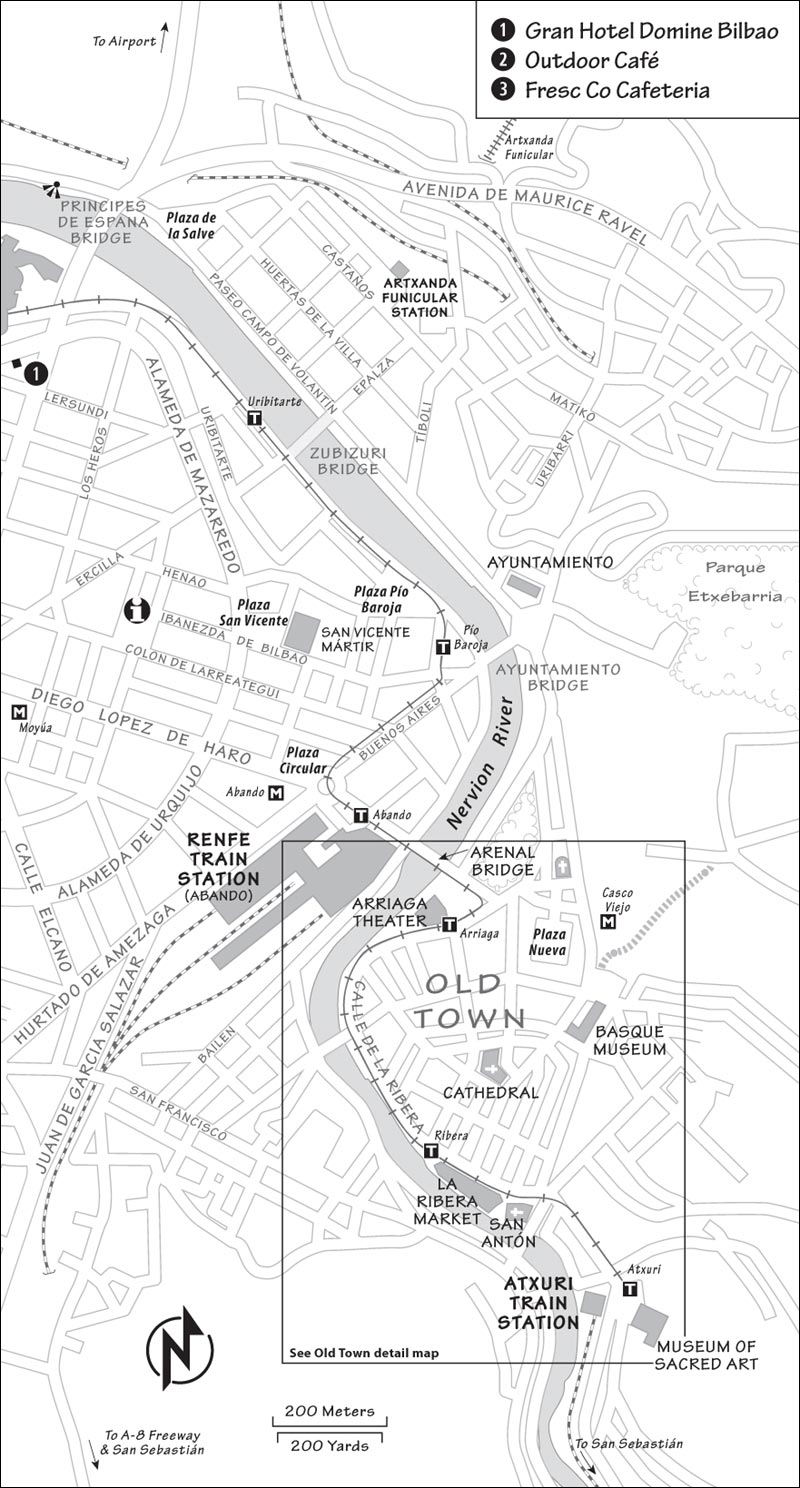
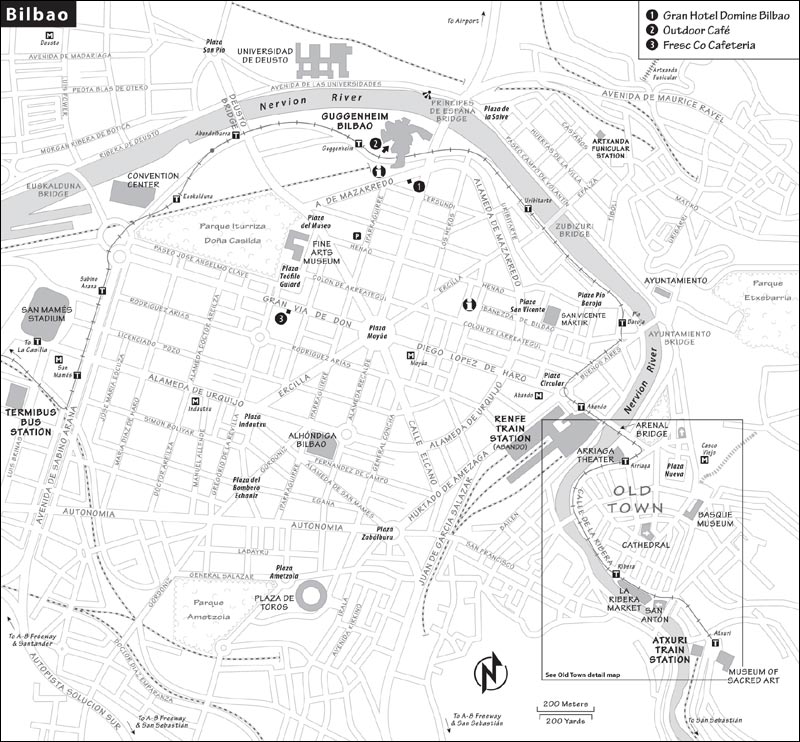
Baggage Storage: The Termibús Bus Station on the west side of the city is your best option (lockers: €1/bag, use tokens from nearby machine; desk: €2/bag, Mon-Fri 7:00-22:00, Sat-Sun 8:00-21:00, Gurtubay 1, tel. 944-395-077).
Laundry: The self-service Lavandería Autoservicio Adei is handy for visitors staying in the Old Town (€7/load, daily 8:00-22:00, Ribera 9, mobile 665-710-082).
Bilbao Walking Tours offers 1.5-hour tours Saturdays and Sundays (more often in summer): an Old Town tour (starts at the Arriaga TI at 10:00—but confirm where tour begins as this location may close in 2014), and a modern-city tour showing the city’s history since the 19th century (starts at the Guggenheim TI at 12:00). Tours are in Spanish and English, and you must call ahead to reserve (€4.50, tel. 944-795-760, www.bilbao.net/bilbaoturismo, informacion@bilbaoturismo.bilbao.net).
Riding the EuskoTran round-trip between the Atxuri and Euskalduna stops is a great way to see the city’s oldest and newest neighborhoods, especially on rainy days. For more on this tram, see “Arrival in Bilbao,” earlier.
The TI runs a decent hop-on, hop-off bus tour around the city. The hour-long trip picks up on the hour outside the Guggenheim TI, and has stops in the Old Town and across the river (€14, ticket good for 24 hours, buy at TI or from driver at any stop, July-Aug daily 11:00-18:00, shorter hours rest of year, no buses Jan-March or Tue in shoulder season, tel. 696-429-848, www.busturistikoa.com).
For a different view of the city, try the Bilboats one-hour tour along the river, offering plenty of architectural Kodak moments. The tour begins near Ayuntamiento Bridge (€12, daily in spring and summer at 13:00, 16:00, 17:30, and 19:00, fewer departures off-season; reserve ahead, as trips are canceled if less than 10 people buy tickets; tram stop: Pío Baroja, Metro stop: Abando; Plaza de Pío Baroja, tel. 946-424-157, www.bilboats.com). For hardcore sailors, a two-hour version goes all the way into the Bay of Biscay on weekends (€17, leaves at 10:30).
Knowledgeable Bilbao resident Iratxe Muñoz offers tours of the city, including the Guggenheim and the Basque region (rates vary, mobile 607-778-072, www.apite.eu/iratxemunoz, iratxe.m@apite.eu).
Although the collection of art in this museum is no better than those in Europe’s other great modern-art museums, the building itself—designed by Frank Gehry and opened in 1997—is reason enough for many travelers to happily splice Bilbao into their itineraries. Even if you’re not turned on by contemporary art, the Guggenheim is a must-see experience. Its 20 galleries, on three floors, are full of surprises, and it’s well worth the entry fee just to appreciate the museum’s structural design, which is a masterpiece in itself.
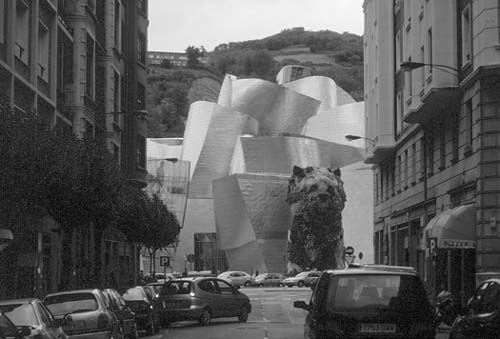
Cost and Hours: €13, includes excellent audioguide; July-Aug daily 10:00-20:00; Sept-June Tue-Sun 10:00-20:00, closed Mon; same-day re-entry allowed—get wristband on your way out; café, no photos inside galleries, tram stop: Guggenheim, Metro stop: Moyúa, Avenida Abandoibarra 2, tel. 944-359-080, www.guggenheim-bilbao.es.
Tours: Free, one-hour guided tours in Spanish generally run 2/day, at 12:30 and 17:00. Show up at least 30 minutes early to put your name on the list at the tour desk (to the left as you enter). Guided tours in English are available only by advance reservation and with a fee (€95 for up to 20 people).
Background: Frank Gehry’s groundbreaking triumph offers a fascinating look at 21st-century architecture. Using cutting-edge technologies, unusual materials, and daring forms, he created a piece of sculpture that smoothly integrates with its environment and serves as the perfect stage for some of today’s best art. Clad in limestone and titanium, the building connects the city with its river. Gehry meshed many visions. To him, the building’s multiple forms jostle like a loose crate of bottles. The building is inspired by a silvery fish...and also evokes wind-filled sails heading out to sea. Gehry keeps returning to his fish motif, reminding visitors that, as a boy, he was inspired by carp...even taking them into the bathtub with him.
 Self-Guided Tour: The audioguide will lead you room-by-room through the collection, but this information will get you started.
Self-Guided Tour: The audioguide will lead you room-by-room through the collection, but this information will get you started.
Guarding the main entrance is artist Jeff Koons’ 42-foot-tall West Highland Terrier. Its 60,000 plants and flowers, which blossom in concert, grow through steel mesh. A joyful structure, it brings viewers back to their childhoods—perhaps evoking humankind’s relationship to God—or maybe it’s just another notorious Koons hoax. One thing is clear: It answers to “Puppy.” Although the sculpture was originally intended to be temporary, the people of Bilbao fell in love with Puppy—so they bought it.
Descend to the main entrance. After buying your ticket, be sure to pick up the free exhibit audioguide. At the information desk, pick up the small English brochure explaining the architecture and museum layout, and the seasonal Guggenheim Bilbao magazine that details the art currently on display.
After presenting your ticket, enter the atrium. This acts as the heart of the building, pumping visitors from various rooms on three levels out and back, always returning to this central area before moving on to the next. The architect invites you to caress the sensual curves of the walls. There are virtually no straight lines (except the floor). Notice the sheets of glass that make up the elevator shaft—overlapping each other like a fish’s scales. Each glass and limestone panel is unique, designed by a computer and shaped by a robot...as will likely be standard in constructing the great buildings of the future.
From the atrium, step out onto the riverside terrace. The “water garden” lets the river symbolically lap at the base of the building. This pool is home to four unusual sculptures (the first two appear occasionally throughout the day): a five-part “fire fountain” (notice the squares in the pool to the right); a “fog sculpture” that billows up from below; another piece by Jeff Koons, Tulips, which is a colorful, chrome bouquet of inflated flowers; and the most recent addition, Tall Tree and the Eye by British artist Anish Kapoor. Composed of 73 reflective spheres arranged vertically, the sculpture endlessly reflects both the Guggenheim and the river.
Still out on the terrace, notice the museum’s commitment to public spaces: On the right, a grand staircase leads under a big green bridge to a tower; the effect wraps the bridge into the museum’s grand scheme. The 30-foot-tall spider, called Maman (“Mommy”), is French artist Louise Bourgeois’ depiction of her mother: She spins a beautiful and delicate web of life...which is used to entrap her victims. (It makes a little more sense if you understand that the artist’s mother was a weaver. Or maybe not.)
Gehry designed the vast ground floor mainly to house often-huge modern-art installations. Computer-controlled lighting adjusts for different exhibits. Surfaces are clean and bare, so you can focus on the art. While most of the collection comes and goes, Richard Serra’s huge Matter of Time sculpture in the largest gallery (#104) is permanent. Who would want to move those massive metal coils? The intent is to have visitors walk among these metal walls—the “art” is experiencing this journey.
Because this museum is part of the Guggenheim “family” of museums, the collection perpetually rotates among the sister Guggenheim galleries in New York, Venice, and Berlin. The best approach to your visit is simply to immerse yourself in a modern-art happening, rather than to count on seeing a particular piece or a specific artist’s works.
You can’t fully enjoy the museum’s architecture without taking a circular stroll up and down each side of the river along the handsome promenade and over the two modern pedestrian bridges. (After you tour the museum, you can borrow a free “outdoor audioguide” to learn more—ID required—but it doesn’t say much or take you across the river.) The building’s skin—shiny and metallic, with a scale-like texture—is made of thin titanium, carefully created to give just the desired color and reflective quality. The external appearance tells you what’s inside: the blocky limestone parts contain square-shaped galleries, and the titanium sections hold nonlinear spaces.
As you look out over the rest of the city, think of this: Gehry designed his building to reflect what he saw here in Bilbao. Now other architects are, in turn, creating new buildings that complement his. It’s an appealing synergy for this old city.
Leaving the Museum: To get to the Old Town from the Guggenheim, take the tram that leaves from the river level beside the museum, just past the kid-pleasing fountain (ride it in direction: Atxuri). Hop off at the Arriaga stop, near the dripping-Baroque riverfront theater of the same name. From here, cross the street to enter the heart of the Old Town.
Often overshadowed by the Guggenheim, the Fine Arts Museum contains a thoughtfully laid out collection arranged chronologically from the 12th century to the present. Find minor works by many Spanish artists such as Goya, El Greco, Picasso, Murillo, Zurbarán, Sorolla, Chillida, Tàpies, and Barceló—along with a handful of local painters. Other international artists in the collection include Gauguin, Klee, Bacon, Cassatt, and more. The museum is at the edge of the lovely Doña Casilda Iturrizar Park, perfect for a stroll after your visit.
Cost and Hours: €6, Tue-Sun 10:00-20:00, closed Mon, last entry 15 minutes before closing, a short walk from the Guggenheim at Museo Plaza 2, Metro stop: Moyúa, tel. 944-396-060, www.museobilbao.com.
Bilbao’s new culture and leisure center, designed by French architect Philippe Starck, is worth a quick visit or a lazy afternoon. Not one of the 43 interior columns is alike—the designs are meant to represent the entirety of materials and styles from antiquity to today. The center houses a cinema, auditorium, exhibition spaces, and restaurant. Most impressive is its glass-bottomed rooftop pool—from the atrium below, visitors can gaze up at backstrokers in the water above.
Cost and Hours: Entry to the Alhóndiga itself is free; a €10 day pass gives you access to the pool and sundeck. Mon-Fri 7:00-23:00, Sat 8:30-24:00, Sun 8:30-23:00, 10-minute walk from the Guggenheim at Plaza Arriquibar 4, tel. 944-014-014, www.alhondigabilbao.com.
Funicular de Artxanda—Opened in 1915, this funicular still provides bilbainos with a green escape from their somewhat grimy city. The three-minute ride offers sweeping views of the city on the way to the top of Mount Artxanda, where there’s a park, restaurants, and a sports complex. Bring a picnic on a sunny afternoon, and take a moment to ponder the giant thumbprint sculpture dedicated to Basque soldiers who fought against Franco during the civil war.
Cost and Hours: €1, leaves every 15 minutes, Mon-Sat 7:15-22:00, Sun 8:15-22:00, until 23:00 on summer weekends, cross the Zubizuri Bridge and walk two blocks along Calle Mújica y Burton to the cable-car station, Plaza del Funicular, tel. 944-454-966.
Bilbao’s Old Town, with tall, narrow lanes lined with thriving shops and tapas bars, is worth a stroll. Because the weather is wetter here than in many other parts of Spain (hence the green hillsides), the little balconies that climb the outside walls of buildings are glassed in, creating cozy little breakfast nooks.
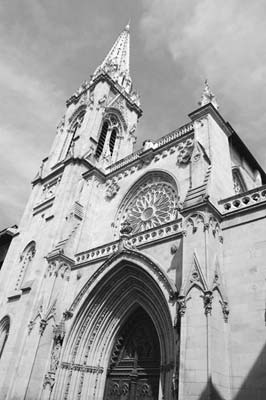
Whether you want to or not, you’ll eventually wind up at Old Bilbao’s centerpiece, the Santiago Cathedral, a 14th-century Gothic church with a tranquil interior that has been scrubbed clean inside and out (free, €1 to dip into cloister, Mon-Fri 10:00-13:00 & 17:00-19:30, closed Sat-Sun, tel. 944-153-627).
Various museums (including those dedicated to diocesan art and the Holy Week processions) are in or near the Old Town, but on a quick visit only one is worth considering...
It’s fitting that Bilbao, a leading city of Spain’s Basque region, would have a museum dedicated to its unique culture. Unfortunately, the almost complete lack of English leaves the exhibits shrouded in mystery—much like the Basques themselves. Around a ground-floor cloister, you’ll see old stone monuments. The first floor delves into the Basque cultural heritage, displaying ceramics, guns, looms, and other tools. Special emphasis is given to nautical artifacts from this seafaring people, Basque settlers in the American West, and the pastoral lifestyles of rural Basques. The top floor is dedicated to archaeology, with exhibits about old tools and settlements.
Cost and Hours: €3, Tue-Sat 11:00-17:00, Sun 11:00-14:00, closed Mon, Miguel de Unamuno Plaza 4, tel. 944-155-423, www.euskal-museoa.org/es.
La Ribera Market—With a new, three-star Michelin restaurant, Bilbao seems poised to give San Sebastián a run for its money as culinary capital of the Basque Country. As part of an urban renewal plan, the 1929 La Ribera city market has recently reopened to an enthusiastic public. Stroll the stalls for the freshest fish (look for the busiest sellers), shop for produce, and admire a series of Art Deco stained-glass panels on the top floor. The city’s coat-of-arms, with two wolves, can be found in the largest panels. There’s been a market here since Bilbao was founded in 1300.
Cost and Hours: Free entry, Mon-Fri 8:00-14:00 & 17:00-19:00, Sat 8:00-14:30, closed Sun, tel. 946-023-791, www.mercadodelaribera.net.
(€1 = about $1.30, country code: 34)
Bilbao merits an overnight stay. Even those who are interested only in the Guggenheim find that there’s much more to see in this historic yet quickly changing city.
$$$ Gran Hotel Domine Bilbao is the place for well-heeled modern-art fans looking for a splurge close to the museum. It’s right across the street from the main entrance to the Guggenheim and Jeff Koons’ Puppy. The hotel is gathered around an atrium with a giant “stone tree” and other artsy flourishes, and its decor (by a prominent Spanish designer) was clearly inspired by Gehry’s masterpiece. The 145 plush rooms are distinctly black, white, steel, and very postmodern (standard Db-€130-200, museum-view “executive” rooms for €50 more, rates vary widely with events and demand, breakfast-€26, air-con, elevator, free guest computer and Wi-Fi, great museum-view breakfast terrace, free gym with wet and dry saunas, Alameda Mazarredo 61, tel. 944-253-300, www.granhoteldominebilbao.com, recepcion.domine@hoteles-silken.com). If arriving by tram, take the main museum steps up by the fountains to reach the hotel.
To reach the Old Town, take the tram to the Arriaga stop.
$$ Hotel Bilbao Jardines is a fresh new place buried in the Old Town with 32 modern but basic rooms with squeaky floors (Sb-€58, Db-€75, less off-season, breakfast-€5, quieter rooms in back, air-con, elevator, free Wi-Fi, free rental bicycles, Calle Jardines 9, tel. 944-794-210, www.hotelbilbaojardines.com, info@hotelbilbaojardines.com, Marta, Felix, and Monica).
$$ Tryp Arenal is a chain hotel with simple, business-class rooms and helpful staff in a great location across from the Arriaga Theater (Db-€60-80, breakfast-€8, air-con, elevator, free Wi-Fi, Calle Los Fueros 2, tel. 944-153-100, www.melia.com, tryp.arenal@melia.com)
$ Iturrienea Ostatua, next door to the recommended Kasko restaurant on a pedestrian street in the Old Town, is a tidy, B&B-style accommodation renting 21 rooms packed with brick, stone, and antiques (Sb-€50, Db-€60, twin Db-€66, Tb-€80, breakfast-€6, free Wi-Fi, near the river at Santa María 14, tel. 944-161-500, www.iturrieneaostatua.com, info@iturrieneaostatua.com, friendly Igone).
$ Hotel Arriaga offers 21 traditional but well-maintained rooms and a spirited reception (Sb-€45, Db-€54, extra bed-€16, some rooms overlook a busy street—request a quiet back room, free guest computer and Wi-Fi, lounge, parking-€8, Ribera 3, tel. 944-790-001, www.hotelarriaga.es, info@hotelarriaga.es, Jon). As you cross the bridge from the station, it’s just behind the big theater of the same name.
$ La Estrella Ostatu is a family-run establishment with 26 simple but neat rooms up a twisty staircase near the Basque Museum (Sb-€35, Db-€60 in summer, cheaper off-season, breakfast-€3-4, María Muñoz 6, tel. 944-164-066, www.la-estrella-ostatu.com, laestrellabilbao@yahoo.es, just enough English spoken, Jesus and Begoña).
$ Pensión Ladero, renting 12 ramshackle but clean and cheap rooms, is a fine budget option in the Old Town. They don’t accept reservations, so call upon arrival to check availability (S-€22, D-€32, T-€50, Q-€60, up 4 flights of stairs; some rooms up a very tight spiral staircase—watch your head—share one bathroom, while remaining rooms use the other three bathrooms on the main floor; cash only, Lotería 1, tel. 944-150-932, www.pensionladero.es, Margarita). You’ll find the pensión just before the cathedral at the center of the Old Town.
(See “Bilbao” map, here.)
The easiest choice is the good cafeteria in the museum itself (upper level, separate entry above museum entry; Tue-Sun 9:30-20:00, closed Mon, €25 lunch deal offered 13:00-15:15, reservations smart, tel. 944-239-333).
The circular structure outside the museum by the playgrounds and fountains is a pleasant outdoor café serving €2.50 tapas (point at the ones you like on the bar). If the tables are full, you can take your food to one of the stone benches nearby. In the evenings, they sometimes have live music.
The streets in front of the museum have a handful of both sit-down and carry-out eateries (cafés, pizzerias, sandwich shops) to choose from. National chain Fresc Co is a healthy and cheap option for lunch or dinner, with an all-you-can-eat salad buffet including some hot dishes, dessert, and coffee for less than €10 (daily 12:30-24:00, 10-minute walk from the Guggenheim, three blocks west of Plaza Moyúa at Gran Vía 55).
(See “Hotels & Restaurants in Bilbao’s Old Town” map, here.)
Bilbao has developed a thriving restaurant and tapas-bar scene in recent years. For pointers on Basque food, see here. You’ll find plenty of options on the lanes near the cathedral. Most restaurants around the Old Town advertise a fixed-price lunch for around €12; some close for siesta between 16:00 and 20:00.
The street called Calle del Perro is tops for the tasty little tapas called pintxos (PEEN-chohs). Xukela Bar is my favorite, with its inviting atmosphere, good wines, and an addictive array of €1.60 tapas spread along its bar (tables only for clients eating hot dishes, Calle del Perro 2, tel. 944-159-772). Calle del Perro is also good for sit-down restaurants. Browse the menus and interiors and choose your favorite. Well-regarded options include three places virtually next door to each other: Egiluz (€11 meals served in small restaurant up steep spiral staircase in the back); Río-Oja (€8 specialties, focus on shareable traditional dishes called cazuelitas); and Rotterdam (€10-15 plates, also has cazuelitas; try the chipirones en su tinta—squids in their own ink, served with a glass of house red for €11).
The street called Calle Santa María caters to a younger crowd, with softer lighting and a livelier atmosphere, and has three bars worth considering: Gatz, Santa María, and Kasko. Kasko is the most upscale option, with stuffy service, a pianist, and an interesting fixed-price dinner (starter, main course, dessert, and good wine served 20:30-23:00 for €27 Sun-Thu and €32 Fri-Sat, Santa Maria 16, tel. 944-160-311, www.restaurantekasko.com).
Eateries also abound on Jardines street, including the popular Berton (meals and pintxos, at #11, closed Mon, tel. 944-167-035). Gorbea brings a splash of modernity into the Old Town, with younger but professional wait staff serving generous portions of modern cuisine and traditional Basque classics (at #3, tel. 944-795-482, www.restaurantegorbea.net). La Deliciosa is just that, with a whopping eight choices for each course (at #1, tel. 944-150-944).
(See “Hotels & Restaurants in Bilbao’s Old Town” map, here.)
There’s not much on the main facade to distinguish it, but stepping through La Granja’s revolving doors is like entering a time machine. Founded in 1926, the interior seems more like a dusty gentlemen’s club than a restaurant. The food is simply presented with oh-so-correct waiters and classic white tablecloths. It’s a good spot to fuel up on coffee before hopping on the tram to the Guggenheim (€13.50 fixed-price lunch, daily, at Plaza Circular 3 but look for rear entrance on Calle Ledesma, tel. 944-230-813).
From Bilbao by Bus to: San Sebastián (2/hour, hourly on weekends, 6:30-22:00, 1.25 hours, arrives at San Sebastián’s Amara Station), Guernica (4/hour, fewer on weekends, 40 minutes), Lekeitio (hourly, 1.25 hours), Pamplona (5-6/day, 2 hours), Burgos (8/day, fewer on weekends, 2-3 hours), Santander (hourly, 1.5 hours, transfer there to bus to Santillana del Mar or Comillas). These buses depart from Bilbao’s Termibús Station (www.termibus.es).
By EuskoTren to: San Sebastián (hourly, long and scenic 2.5-hour trip to San Sebastián’s Amara EuskoTren Station, €9.15 round-trip ticket saves €1.50, EuskoTren info: tel. 902-543-210, www.euskotren.es), Guernica (2/hour, 50 minutes, take Bilbao-Bermeo line, direction: Bermeo). These trains depart from Bilbao’s Atxuri Station, just beyond the Old Town past the Ribera Market.
By RENFE Train to: Madrid (4/day, 5 hours), Barcelona (2/day, 6.5 hours), Burgos (3/day, 2.5-3 hours), Salamanca (3/day, 6 hours), León (1/day, 5 hours). Remember, these trains leave from the RENFE station, across the river from the Old Town (tram stop: Abando). A planned new train line (coming in 2017) will connect Bilbao to other cities in a snap (30 minutes to San Sebastián, 2.25 hours to Madrid, 5.5 hours to Paris)—but it’s still slow trains for now.